#weekly shonen sunday magazine
Text

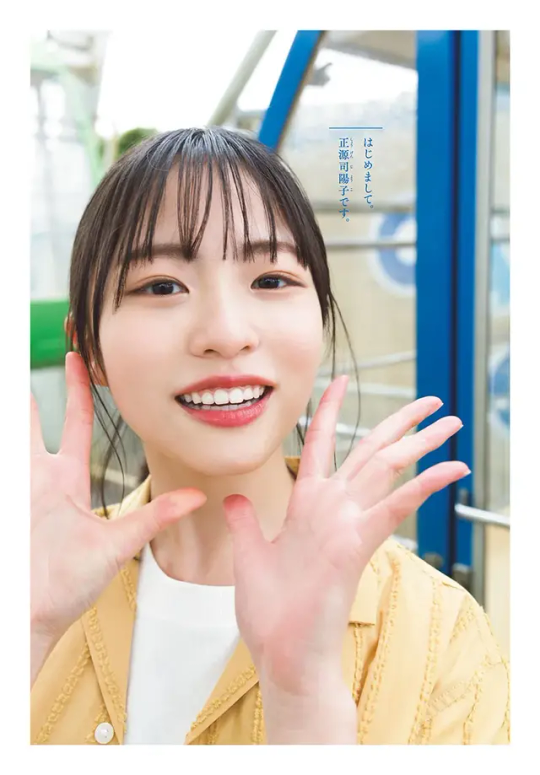







週刊少年サンデー No.24 2023年5/24号 (2023/5/10)
''はじめまして。正源司陽子です。'' 正源司陽子 from 日向坂46
23 notes
·
View notes
Text
art by zackmolis
3 notes
·
View notes
Text
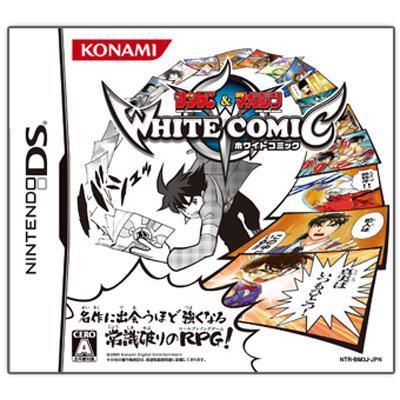
I want to play this game so badly that it's not a want, it's a NEED.
#a crossover game between shonen sunday and shonen magazine#which features almost all the series im so normal over????#this was made just for me#like uy ranma inuyasha detco gsm touch kindaichi and more??#and with like atleast a good number of characters from each??#hopefully i get my hands on this one day#and i would love to see a translated version as well!!#weekly shonen sunday#shonen magazine#shonen sunday & shonen magazine white comic#video games#wishlist#I NEED THIS SO BADLY
2 notes
·
View notes
Text
Enako Cosplayer Jepang Terpopuler, Tampil Menggemaskan dengan Kostum Tahun Naga
Berita Cosplay Jepang – Penampilan Menggemaskan Enako, Cosplayer Jepang Terpopuler, dalam Kostum Tahun Naga.
Majalah antologi manga paling populer di Jepang diterbitkan setiap minggu. Baik Anda adalah pembaca setia Weekly Shonen Jump dari penerbit Shueisha, Weekly Shonen Sunday dari Shogaukan, atau Weekly Young Magazine dari Kodansha, Anda tidak akan melewati lebih dari tujuh hari antara bab baru…
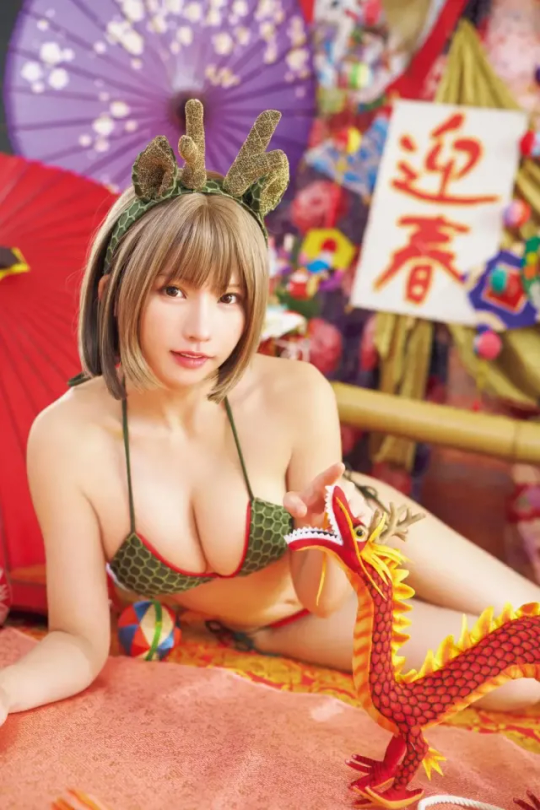
View On WordPress
#Berita Cosplay Jepang#Cosplayer Jepang Terpopuler#Weekly Shonen Jump#Weekly Shonen Sunday#Weekly Young Magazine
0 notes
Text
For the 10th anniversary of Inuyasha, in the magazine "Weekly Shonen Sunday No 50" of 2006, Rumiko Takahashi herself selected her top 10 favorite scenes from the manga and, among the 10 scenes, there is also Kagura's death and in the comment she mentions Sesshomaru! 🥰🥰🥰
The image that was chosen to represent this scene is the moment in which Sesshomaru appears in front of Kagura.

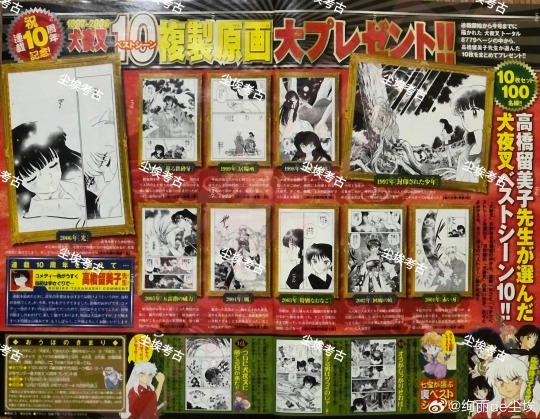



How many things they (you know who...) said about this scene... they said it's forced, exaggerated, overplayed, fanservice, Sesshomaru wasn't supposed to be there etc. etc. 🙄 The TRUTH is that this scene is one of her favourites!!! 🤗🤗🤗 Because she loves Kagura, first of all, but also she likes how she made this scene, including Sesshomaru being there!
#Inuyasha#Sesshomaru#Kagura#SessKagu#犬夜叉#殺生丸#神楽#殺神#이누야사#셋카구#셋쇼마루#카구라#杀生丸#神乐#杀乐#sesshoumaru x kagura#sesshoumaruxkagura#kagura of the wind
45 notes
·
View notes
Text
Shoujo Manga's Golden Decade (Part 2)
Shoujo manga, comics for girls, played a pivotal role in shaping Japanese girls’ culture, and its dynamic evolution mirrors the prevailing trends and aspirations of the era. For many, this genre peaked in the 1970s. But why?
Part 1
The Year of 24 Group
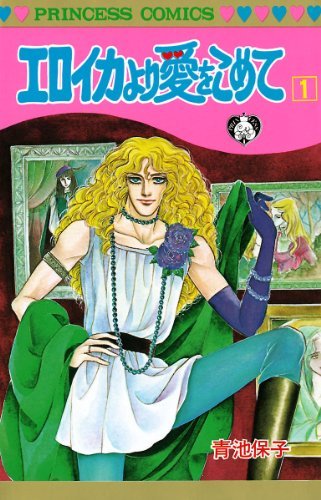
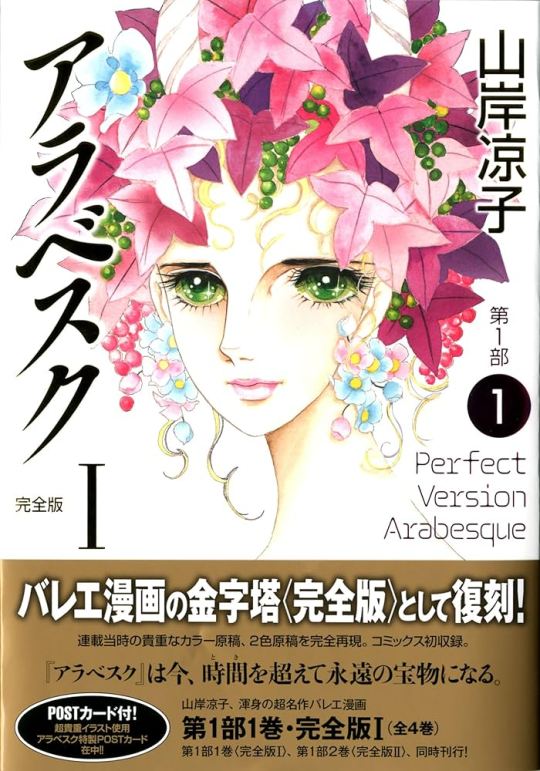
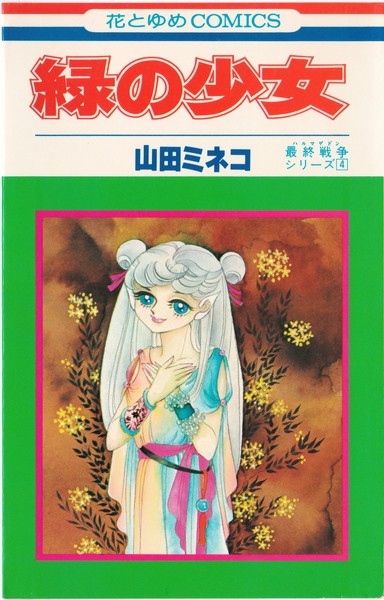

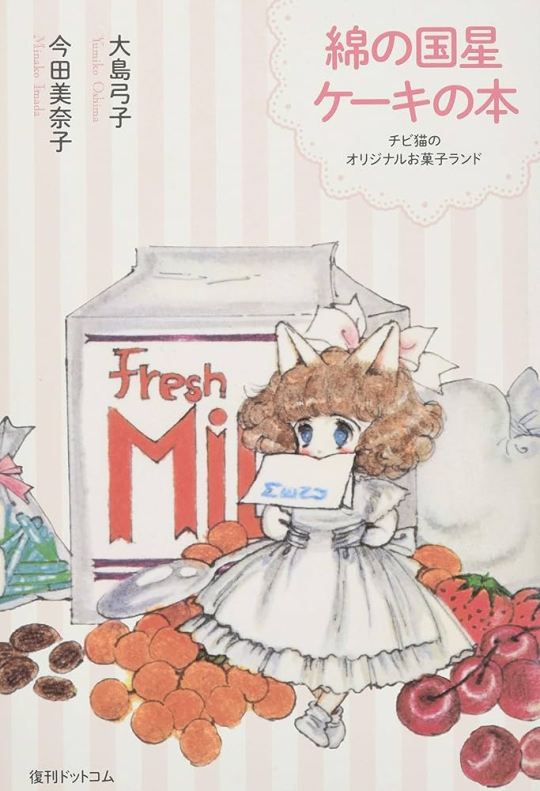

Some of the best-selling work by the Year 24 Artists (l-to-r): Yasuko Aoike's "From Eroica with Love," Ryoko Yamagishi's "Arabesque," Mineko Yamada's "Minori no Shoujo," Toshie Kihara's "Yomie no Ishibume," Yumiko Oshima's "The Star of Cottonland," Yuuko Kishi's "Tamasaburo."
Back in the early '70s, there was the prevailing notion that manga was for young kids. Despite the variety in themes, big magazines like Margaret, Shoujo Club, Nakayoshi, and Ribon were theoretically aimed at elementary school-aged girls.
In practice, the reality was more nuanced. Due to being published in Weekly Margaret, "The Rose of Versailles" was for kids. And it did very well with them. Yet, its revolutionary romance also appealed to broader audiences, exemplifying the crossover potential of shoujo manga. It was the title that opened the door for what is known as "the golden age of shoujo," which was further cemented by several other groundbreaking hits.
These hits widened the shoujo manga field, and soon, other editorial houses also wanted to cash in. Shogakukan, which published the powerful Weekly Shonen Sunday, entered the shoujo market in the late '60s. Shueisha and Shogakukan also partnered to form a keiretsu and open the Hakusensha publisher which deals mostly with shoujo manga.
That is the context in which a batch of artists known as "The Magnificent 24 Group" rose. And they were another key reason as to why '70s shoujo made such a mark. These manga-kas introduced themes such as sci-fi and homosexuality to the segment, revolutionized its art, further explored historical and terror narratives, and generally broke barriers of what was possible in shoujo manga. Their work was intellectually challenging, philosophical, and, above all, fundamental for male manga critics and connoisseurs to finally take shoujo seriously.
The Year 24 Group refers to the fact most artists were born around 1949, which is known as the year 24 of the Showa era in the Japanese calendar. These women came of age during the time artists like Hideko Mizuno were debuting and doing revolutionary work in the shoujo field, and they were eager to follow their lead. The success of unorthodox hits like "The Rose of Versailles" and the emergence of new magazines enabled them to be bold.
The two artists who led the movement are Moto Hagio and Keiko Takemiya. Their shared house in Tokyo, known as the Oizumi Salon, became a gathering place for several young artists keen on breaking new grounds for shoujo manga-kas. These women became the Year 24 group. But there were other two people, besides the artists themselves, who were just as crucial for the existence of the movement.
Firstly, there was Junya Yamamoto. Yamamoto was a young male editor at Shogakukan who had risen through the ranks of the successful Shonen Sunday weekly manga magazine. Noticing they were lagging behind Shueisha and Kodansha in the manga segment for their lack of a robust shoujo presence, the editorial house appointed Yamamoto to launch Shoujo Comic (known as Sho-Comi) in 1968 and Bessatsu Shoujo Comic (known as Betsucomi) in 1970. However, he quickly ran into an issue: most successful shoujo artists already had exclusive contracts with the competing houses, and aspiring names were vying for positions at the already established magazines.
In 1969, the "God of manga," Osamu Tezuka, introduced Yamamoto to Keiko Takemiya, then a university student living in Tokushima City. Takemiya had spent her school years dreaming of becoming a manga-ka and participated extensively in the readers' corner section of COM. COM was an avant-garde manga magazine Tezuka founded to nourish young talents and publish stories without the typical restraints of more commercial shoujo and shonen publications. In her first year of college, Takemiya won a Shueisha's Weekly Margaret newcomer competition and had a work published in the magazine. Still, she was persuaded by her parents to focus on her studies instead and to leave manga as a side hobby.
Yamamoto, in turn, was impressed with her talent and convinced her to chase her dreams. Quickly, she found work in all three publishers and started simultaneously publishing in Kodansha, Shueisha, and Shogakukan's shoujo titles.
Meanwhile, Moto Hagio also grew up enamored with the manga world. During her college years, she had a work selected by Shueisha's Bessatsu Margaret (Betsuma) through a competition, but she could not find a fixed slot in the magazine. Then, she got introduced to Kodansha's Nakayoshi editors, who were impressed by her talent. While she did start publishing short stories there, editors rejected most of her submitted work as they did not fit the magazine's mold. One day, an editor introduced her to Takemiya, who, overworked while working for several magazines, was in dire need of an assistant. The two hit off, and Takemiya, who until then had her permanent residence in far away Tokuma City but was planning a move to Tokyo, proposed they both live together. She also decided to introduce Hagio to risk-taker editor Yamamoto, who, impressed by her talent, encouraged her to pursue her path instead of trying to fit into the expected shoujo template.
Then there was Norie Masuyama, who first became acquainted with Moto Hagio before becoming Takemiya's manager. Hagio was from Fukuoka, while Masuyama was from Tokyo, but due to their similar interests, they became penpals. When Hagio first moved to Tokyo, Masuyama hosted her in her home in Oizumi. Eventually, Hagio introduced Masuyama to Takemiya, and the three of them became close. Because both were artists from outside of Tokyo, Masuyama suggested Keiko and Moto should live together, and she was the one who alerted them of a house in her Oizumi neighborhood being up for rent.
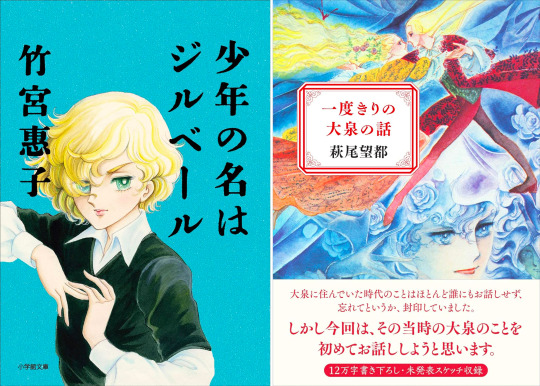
Keiko Takemiya and Moto Hagio, estranged since the late '70s, revealed details of their feud in autobiographic books: Takemiya's "Shonen no na wa Gilbert" (2019) and Hagio's "Ichidou kiri no Oizumi no Hanashi" (2021). The dispute, stemming from Takemiya accusing Hagio of plagiarism, was fueled by Takemiya's jealousy during a challenging creative and personal period. While Takemiya appears self-aware and analytical in her account, Hagio's book indicates she hasn't forgiven Keiko, revealing unresolved feelings. The publications triggered intense online debates.
Masuyama came from a sophisticated family that was very involved in arts and, from a young age, got familiarized with the world of music, literature, and movies. Her refined taste impressed Hagio and Takemiya. At a time when Japanese girls dreamed of Europe, Masuyama actually had friends living there and was up-to-date on the latest European trends. She also had a lot of knowledge of European cinema and literature.
As their rented house was old and rusty, Hagio and Takemiya started spending a lot of time at Masuayama's house across the street. She introduced them to films, songs, books, and paintings. It was Masuyama's taste -- including her interest in movies and books depicting gay romance and her desire for girls' comics to have bolder and riskier themes -- that helped to instill a passion in both artists to go further than the safe cliches usually depicted in shoujo works.
In 1970, editor Yamamoto convinced Takemiya to sign an exclusive contract with Shogakukan. The following year, Hagio also started publishing for Sho-comi and Betsucomi. Their work would attract a loyal fanbase, and aspiring manga-ka would flood their mailboxes. So Takemiya made a decision: to select female artists around her and Hagio's age to mentor and train at their shared home. Thus, the Oizumi Salon was born.
Despite attracting attention, Takemiya and Hagio's works were not always popular. In fact, they'd often rank last in readers' popularity polls, which tend to be all-deciding in manga magazines. But they persevered, and Yamamoto trusted them.

Keiko Takemiya aimed to establish herself with a top-rated series through "Pharaoh no Haka" (left) in order to garner the necessary respect from editors to write the series she wanted, "Kaze to ki no uta" (right). Despite her resolute efforts, "Pharaoh no Haka" never secured the top spot in Sho-comi's readers' poll, peaking at #2. Nevertheless, the series succeeded in elevating her fame and earning her the respect she sought.
In 1972, Hagio had an idea for a serial focused on a male European vampire. However, as she wasn't a famous artist, Yamamoto only allowed her to publish one-shots. So she came up with a plan: to write three interconnected standalone stories. To circumvent another restraint - shoujo editors' avoidance of male leads - she put the first story focus on Marybelle, Edgar's sister. Once Yamamoto realized what Hagio was doing, he was amused and allowed her to continue. And so, "The Poe Clan" series began. In 1974, Shogakukan finally started publishing their shoujo titles in compiled paperback format. In another proof of trust, Yamamoto chose Hagio's "The Poe Clan" as the first title of the Flower Comics imprint.
To everybody's surprise, "The Poe's Clan," in paperback format, was a groundbreaking success, almost instantaneously selling out its initial printing. At the time, Hagio had just started a new serialization, "The Heart of Thomas," a tragic gay love story set in an all-boys German school. As usual for her, the story wasn't all that popular with Sho-Comi's readership, and its lackluster results in the reader's poll almost got the series discontinued. But the notable success of "The Poe's Clan" tankobon assured editors, who allowed Hagio to continue the series. "The Heart of Thomas" went on to become another best-seller and a seminal shoujo title. It also attracted critical acclaim and a loyal fanbase to Moto Hagio, which in turn helped put the Year 24 artists -- who were pretty good at self-promotion -- in the spotlight.
Hagio, Takemiya, and several other "Year 24" authors drifted between being popular and underground. They had a sizable, loyal fanbase that followed them and turned several of their works into best-sellers. On the other hand, by finding a way around the usual shoujo traditions, they weren't particularly popular with the average shoujo reader, ordinary young girls across the country.
Their peculiar position forced them to be clever, so they could fulfill their creative desires as well as their editors' expectations, who were there to make sure the stories published were satisfying to the core readership. Takemiya wrote "Pharaoh no Haka," an Egypt-set romantic adventure, to be well-accepted so that she could then dedicate herself to doing what she truly wanted in "Kaze to Ki no Uta," a gay love story set in a 19th Century French boarding school.
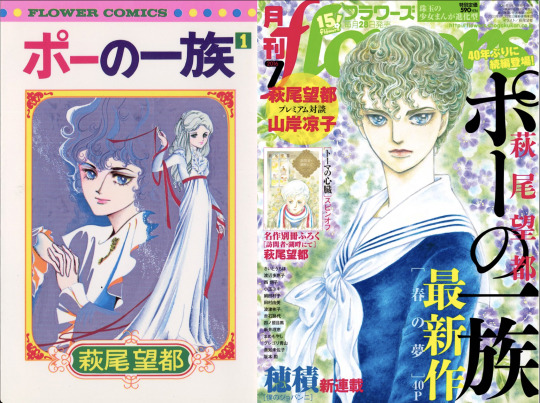
Initially overlooked in popular shoujo magazines, Moto Hagio gained success with "The Poe Clan" in compiled format, launching Shogakukan's Flower Comics imprint. Over time, she became a highly respected manga artist, the only manga-ka alongside legendary filmmaker Hayao Miyazaki to receive a Person of Cultural Merit recognition. In 2016, marking 40 years of the conclusion of her first hit, she released a new "The Poe Clan" chapter in Flower magazine, selling out the increased print run of 50,000 copies in a day. This success marked a significant shift for Hagio, who, despite not being a major magazine seller in earlier years, became a valuable asset to the struggling publishing industry. Following the one-shot, she released three more chapters and, in 2022, began a new sequel series.
Besides Takemiya and Hagio, several other notable shoujo artists who went on to become huge names used to frequent the Oizumi Salon and were part of the "Year 24 group." In the early '70s, most published their work on Shogakukan's titles, which had a "free policy" on storytelling compared to Margaret, Shoujo Friend, Nakayoshi, and Ribon. Then, as Shogakukan started being more strict to properly compete with the market leaders, several moved to newly launched Hakusensha titles Hana to Yume and LaLa. Influential names that were part of the movement included Yumiko Oshima, Yasuko Aoike, and Ryoko Yamagashi, among several others.
Despite their unorthodox preferences, they weren't necessarily trying to rebel against the system, they simply wanted to put out good quality work they believed in. Like other Japanese girls from that era, they were fascinated by Europe, and plenty of their stories took place on the continent. In 1972, Hagio, Takemiya, Yamagishi, and Masuyama made a 45-day trip to Europe, visiting the Soviet Republic, France, and several other countries, which had a profound impact on them. Still, their narratives were widely innovative. They often had male leads, introduced sci-fi, "boys' love," and other bolder genres to shoujo manga, and contributed to the evolution of shoujo illustration. Above all, this group of artists was the one who made clear to naysayers, once and for all, that shoujo manga is indeed an art form.
But while their influence in manga history is undisputed, other significant -- and much more commercial -- manga movements also shook the shoujo manga world during that decade.
A Need for Drama
When talking about '70s shoujo manga, it's common for minds to drift directly to iconic series from that time, like "Candy Candy" and "Rose of Versailles." But, unlike in present times, in that decade, the manga industry's focus wasn't on successful, long-running series but on the artists themselves.
As opposed to the struggling publishing marketing of today, major shoujo manga magazines all sold over 1 million copies during that decade. Manga in tankobon (standalone paperback) format was turning into a money-maker field, but being able to sell paperback was very much secondary compared to being a name capable of selling magazines. Keiko Takemiya and Moto Hagio, from the Amazing Year 24 Group, would go on to become household names and had best-selling series, but, at the time, they couldn't compete with the actual shoujo manga superstars who were the signboard artists of the Kodansha and Shueisha's shoujo titles, the ones who actually moved publications. These artists' work was the most significant indicator of what the mainstream readers wanted and aspired to back then.
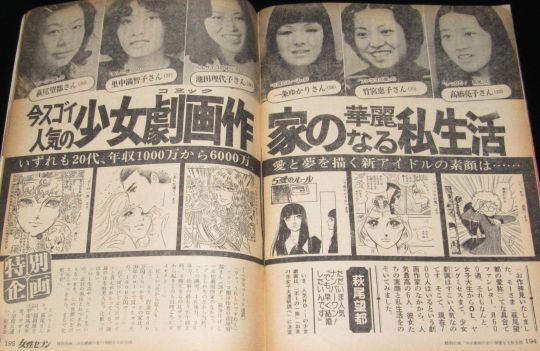
In a December/1975 issue, weekly Josei Seven spotlights the new generation of superstar shoujo manga artists: (l-to-r) Moto Hagio, Machiko Satonaka, Ryoko Ikeda, Yukari Ichijo, Keiko Takemiya, and Ryoko Takahashi. While contemporary manga-kas are highly discreet about their lives and do not even tend to show their faces, in the '70s, they were treated like superstars, and, in the article, the manga-kas openly discuss their love life and details of their high incomes, including how much they had in the bank and how much they spent on rent and daily utilities.
For Kodansha, the top shoujo artist was definitely Machiko Satonaka, who won the Best New Artist competition in 1964, when she was still a freshman in high school. There have been several high-schoolers making their debut in the industry throughout the decades, but, as the first, Satonaka caused a media frenzy. Her ascent gave confidence to countless other young women -- from "Glass Mask"'s Suzue Michi to Keiko Takemiya (who also won a smaller prize in the same competition) -- to pursue their manga careers.
The attention surrounding Satonaka, who went on to become a public personality with TV hosting gigs and other appearances, is another interesting, nostalgic phenomenon. In the past, it was common for manga superstars to have a strong media presence. Nowadays, the norm is the complete opposite: for manga-kas to be highly private, no matter how famous their work is.
In any case, Satonaka quickly proved herself to be more than a sensational news story as she created extremely popular mangas for Kodansha shoujo titles like Shoujo Friend and Nakayoshi. Her style, widely accepted by readers, became symbolical of the story-telling the '70s girls craved: extremely dramatic with emotionally driven plots and lots of bombastic twists and developments.
In his book on subcultures and otaku culture, sociologist Shinji Miyadai notes that '70s shoujo manga can be divided into very few categories. There is the category the Year 24 artists dominated -- which he defines as the "Moto Hagio domain" -- of works with a lot of artistic value, up-to-par with literature. And then there's the far more commercially viable "Satonaka domain," which represented the mainstream taste.
In the "Satonaka category," the artist depicts a stormy life story as a proxy experience for the readers. Of course, there are universal elements of love, friendship, and insecurity that girls can directly relate to. Still, these stories provide adventures that readers could never experience in the real world.
These facets of the "Satonaka domain" are present in almost all the best-selling, mainstream shoujo series of the '70s, like the revolutionary historical romance of "The Rose of Versailles," the dramatic rags-to-riches story of the beautiful orphan in "Candy Candy," and the rise of an ordinary girl to the top of the sports elite in "Ace wo Nerae." In all of these titles, you'll also spot other defining characteristics of '70s shoujo: the death of beloved characters and beloved female characters with voluminous blonde hairs and huge, sparkling eyes (a legacy of Macoto Takahashi, the illustrator who, throughout the '50s, created the art that directly influenced subsequent shoujo history).
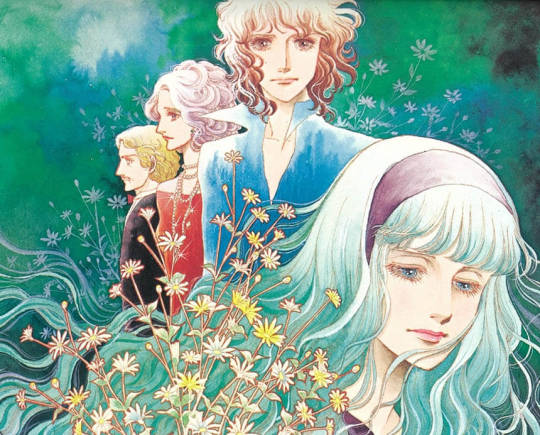
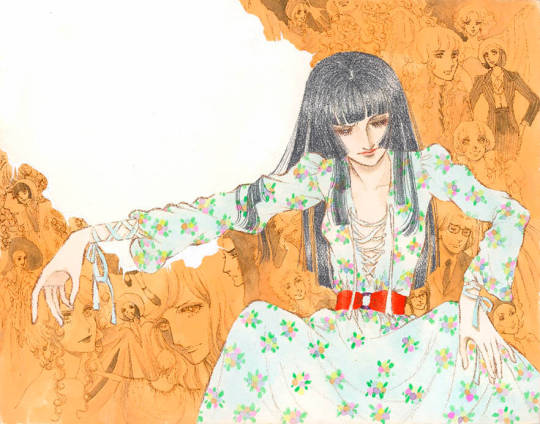
Yukari Ichijo was the most prominent Ribon signboard artist throughout the '70s, creating popular mangas like "Suna no Shiro" (left) and "Designer (right). Young girls across the country adored her work despite the adult drama in it.
Since these stories are extraordinary and dream-like, many of them use Europe or the US as their setting, another reflection of the times when Japanese youth dreamed with the West.
While Satonaka was Kodansha's star, Shueisha also had its top shoujo artists. For Margaret, it was Ryoko Ikeda who kept creating memorable dramatic manga after the conclusion of "The Rose of Versailles." Other classic '70s dramatic works published in the weekly included Kyoko Ariyoshi's ballet drama "Swan." Meanwhile, over at Ribon, no one shone brighter than Yukari Ichijo. Ichijo's works, which young girls across Japan devoured, contained a lot of adult drama with adult characters. Her 1974 manga, "Love Game," had a bed scene. One of her most celebrated works of the decade, "Suna no Shiro" (Sand Castle), dealt with incest. While Ichijo is the one who stood the test of time, another artist who also enjoyed great popularity in Ribon following this formula was Kei Nogami.
These mangas served as an escape for girls, who left their ordinary school life behind for a few hours to embark on extraordinary adventures. In contrast, one of the main genres in contemporary shoujo is unassuming, everyday high school romance. How could the shoujo segment go through such a drastic transformation? The reasons for that also dates back to the 1970s.
Part 3
#shoujo manga#vintage shoujo#otometique#yumiko oshima#keiko takemiya#yumiko tabuchi#hideko tachikake#machiko satonaka#yukari ichijo#ribon#1970s japan#1970s#year 24 group#moto hagio#vintage manga
38 notes
·
View notes
Photo
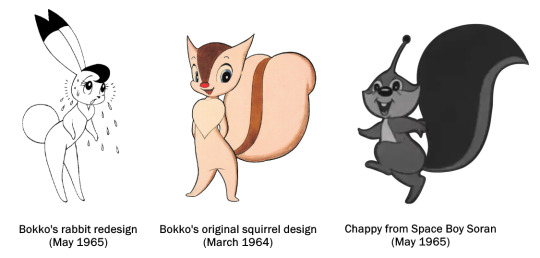


The Wonder 3 controversy (W3事件)
In March 1964, Osamu Tezuka pitched a manga idea to Weekly Shonen Magazine that he hoped would turn into his third anime for his animation studio, Mushi Productions. The manga would be a spy thriller entitled Wonder 3, and would follow a detective solving crimes with an alien squirrel named Bokko.
However, in June of the same year, Tezuka learned of an anime in production at TBS (Tokyo broadcasting station) entitled Space Boy Soran. The anime followed a cyborg boy named Soran, who helped fight crime and save the earth with an alien squirrel named Chappy. Tezuka was shocked when he heard the news, as the pitch for Wonder 3 and the design for Bokko were not shown to the public.
Osamu Tezuka immediately opened an investigation at Mushi Productions, and found out several of his animators also worked at TBS. Several staff members of Mushi Pro were either fired of left as they were threatened to be arrested for industrial espionage. While it is not known to this day who exactly leaked the information, it was likely an accidental slip up from a former animator and not a malicious act.
Due to how far Space Boy Soran was into production compared to Wonder 3, Tezuka had to completely scrap the spy thriller concept and start from scratch. In the end, he made Wonder 3 about three aliens invading earth and taking the form of a rabbit, a duck, and a horse. Bokko from the original spy concept was kept, though she was redesigned to be a rabbit and not a squirrel.
Osamu Tezuka also changed the magazine Wonder 3 was published in from Weekly Shonen Magazine to Weekly Shonen Sunday, as the Space Boy Soran manga that was being produced the same time as the anime was running in Weekly Shonen Magazine.
54 notes
·
View notes
Text
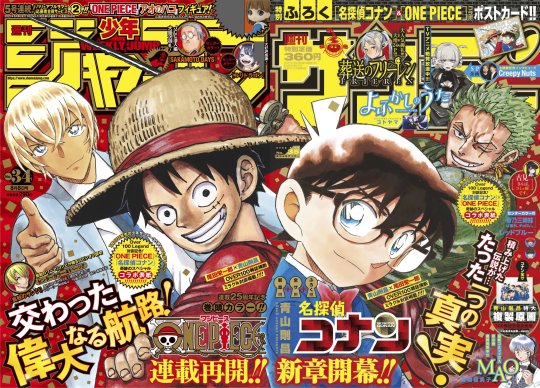
Cover of Weekly Shonen Jump and Weekly Shonen Sunday magazine on the occasion of historical dialogue between Eiichiro Oda and Gosho Aoyama.
#one piece#detective conan#gosho aoyama#eiichiro oda#luffy#zoro#one piece manga#conan edogawa#topijeramimy#topijerami.my#one piece malaysia#malay#malaysia#kru topi jerami#shonen jump
186 notes
·
View notes
Photo
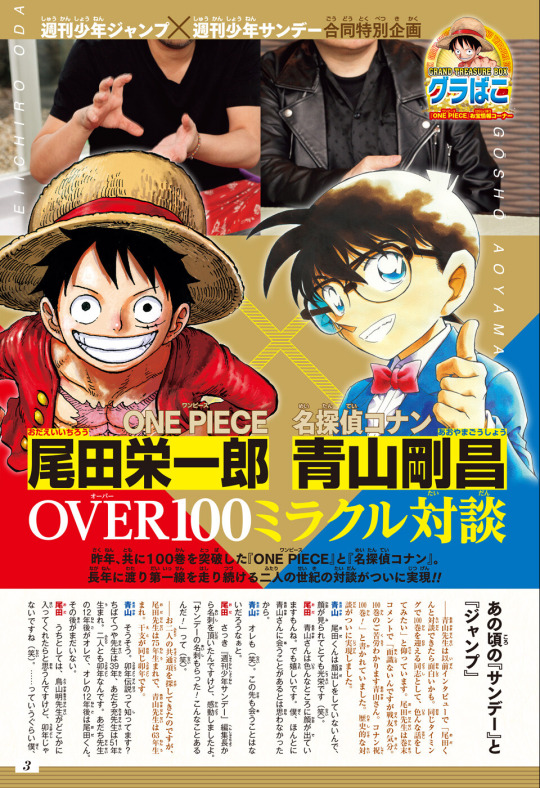
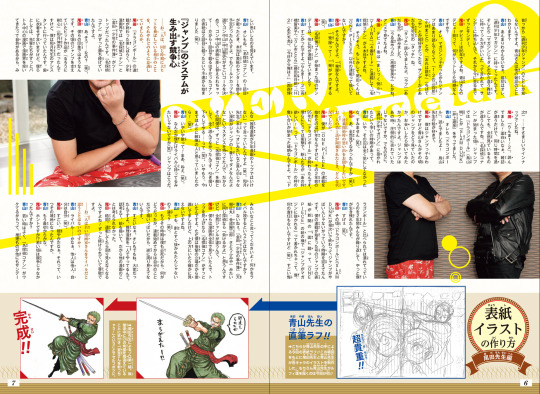


Eiichiro Oda x Gosho Aoyama OVER 100 Miracle Talk that was featured in Weekly Shonen Jump 2022 issue #34 and Weekly Shonen Sunday issue #35.
Eiichiro Oda x Gosho Aoyama OVER 100 Miracle Talk - Part 1
Last year, both One Piece and Detective Conan surpassed 100 volumes. A miraculous dialogue between the two mangaka who have been at the forefront of the manga industry for many years has finally come to fruition!!
‘Jump’ and ‘Sunday’ Back Then…
– In a previous interview, Aoyama-sensei said that “it’d be interesting to have a talk with Oda-kun. As comrades who will reach 100 volumes simultaneously, I would like to talk about various things”. Oda-sensei answered in a comment that he “had never met him, but feels like a comrade in arms. I know how tough getting to 100 volumes is, Aoyama-san! Congrats on 100 volumes of Conan!”. This legendary talk is now finally coming true.
Aoyama: Oda-kun doesn’t really show his face much, so it’s an honor to actually see it haha.
Oda: Aoyama-san does show his face in a lot of places, though. But I’m really happy. I didn’t think I’d ever met you.
Aoyama: Me neither haha. I always thought there wouldn’t ever be a future in which I met you.
Oda: I was pretty impressed earlier because I got a business card from Weekly Shonen Sunday’s Editor-in-Chief. “I got a Sunday business card! This kind of stuff actually happens!”, haha.
– I have been looking for something you have in common, and it seems Oda-sensei was born in 1975 while Aoyama-sensei was born in 1963. You both share the same zodiac sign having been born in the Year of the Rabbit.
Aoyama: That’s right. Do you know about that Year of the Rabbit legend? Tetsuya Chiba-sensei was born in 1939, and Mitsuru Adachi-sensei was born in 1951. Both of them were also born in the Year of the Rabbit, separated by 12 years. I was also born 12 years after Mitsuru Adachi-sensei, and you were born 12 years exactly after me. We got no one after that.
Oda: I wish we could fit Akira Toriyama-sensei somewhere, but he doesn’t belong to the Year of the Rabbit haha. …I do have to recognize I have only known much about Weekly Shonen Jump. Do you have knowledge on other magazines, Aoyama-san?
Aoyama: Not really. At first, I brought my work to Weekly Shonen Magazine, and I was told “it didn’t really fit with them, so take it to a different publication”. That’s when I brought my work to Sunday, and that’s where I have been since then.
Oda: You made your debut in 1986, right? What hits were there back before you debuted?
Aoyama: Well, I was a ‘Magazine Kid’, so it’s not like I read much of Jump, but I still enjoyed works like ‘1·2 no Sanshirou’ by Makoto Kobayashi and ‘Ore wa Teppei’ by Tetsuya Chiba. When it comes to Sunday, it was Mitsuru Adachi’s ‘Touch’.
Oda: I did read ‘Touch’, and also Mitsuru Adachi’s ‘Rough’.
Aoyama: I also remember watching Rumiko Takahashi’s ‘Urusei Yatsura’ TV Anime.
Oda: After debuting, you serialized ‘Magic Kaito’, ‘YAIBA’ and ‘3rd Base 4th’, being ‘Detective Conan’ your fourth work.
Aoyama: Right. Meanwhile, Oda-kun hasn’t drawn any series other than ONE PIECE?
Oda: Indeed. I’m a one-hit wonder.
Aoyama: A one-hit wonder! With a way-too-big one-hit haha.
Oda: What other series were serializing on Sunday when you started ‘Detective Conan’?
Aoyama: Well, it was a truly amazing time back then. Rumiko Takahashi’s ‘Ranma ½’, Kazuhiro Fujita’s ‘Ushio to Tora’, Mitsuru Adachi’s ‘H2’, Nishimori Hiroyuki’s ‘Kyou Kara Ore Wa!!’... The line-up was absolutely terrifying.
Oda: I did read ‘Ranma ½’, it was really fun! Just reading different magazines, no matter how much time you spend on it, what you end up reading or seeing is completely different too. Back when ‘Detective Conan’ started, Jump had Akira Toriyama’s ‘Dragon Ball’ and Takehiko Inoue’s ‘SLAM DUNK’.
Aoyama: I read ‘Dragon Ball’! I love Toriyama-sensei’s art.
Oda: I was a ‘jumper’ at that time, but this is something I wanted to ask you if we could ever meet: how did you view Jump back then? Jump sales were incredibly overwhelming during that time, but a bit of conflict came later when Weekly Shonen Magazine surpassed its circulation numbers.
Aoyama: I have to apologize, but I didn’t care at all about that haha.
Oda: Ah, so you didn’t even bother with it haha.
– I would like to ask about your thoughts and memories back when your series started. When you both published your very first chapter, what was it like?
Oda: I started serializing ‘ONE PIECE’ in 1997, two years after ‘Dragon Ball’ ended in 1995. It was a shock for all of us newcomers who came to the magazine to claim the series’ abandoned throne. At that time, the fight for the place ‘Dragon Ball’ left would begin, and for 2 years everyone would get their series compared and completely crushed, until I finally survived.
Aoyama: Amazing haha.
Oda: It was a time in which both ‘Dragon Ball’ and ‘SLAM DUNK’ ended right after the other, and lots of people thought Jump would be in huge trouble. I remember the cover of the Jump issue in which my series started appeared on the front page of a newspaper, showing the cover of ‘ONE PIECE’ next to the headline ‘Jump is overtaken by Magazine’. And it’s not like I had any responsibility over it at all haha, but I still remember feeling really frustrated.
Aoyama: As for me, when the first chapter of ‘Detective Conan’ was going to be published, I was supposedly going to appear at the center of the cover of the magazine. Thing is, during the World Cup Preliminaries, Masashi Nakayama scored a really great goal and my cover was replaced with him… That’s why Conan’s cover, which was supposed to appear with the first chapter of the series, had the bad luck to appear with the second chapter instead haha.
The Competitive Spirit Created by Jump
– What do you two think of each other and other mangaka who also have successful works?
Oda: After ‘Dragon Ball’ ended, the world of shonen manga was dominated by two works, ‘Detective Conan’ and ‘The Kindaichi Case Files’. Conan was always winning.
Aoyama: Ah… Seriously? Haha.
Oda: That was indeed my perspective. Jump’s supporting hit work back then was ‘Rurouni Kenshin’ by Nobuhiro Watsuki. I was one of Watsuki-sensei’s assistants. I won’t really hesitate saying this, we were proud our seniors led the shonen manga world with battle-focused manga, so we honestly thought “mystery manga shouldn’t be at the top of shonen manga” haha. Watsuki-sensei himself had the stance that “if a series wasn’t always performing like his, it couldn’t be at the top of Jump”. That’s why I always considered ‘Detective Conan’ an enemy to me and thus didn’t read it. I even had thoughts such as “I’ll drag you down, haha…”. Not joking, I used to think of you as an enemy until now haha!
Aoyama: No way, an enemy!? Oh my haha!
Oda: Looking at your reply, it seems it was only me who thought we had some sort of rivalry haha. Please, say something like “that’s how Jump should be”! Have you ever looked at someone as a rival?
Aoyama: Not really. When it comes to Kanari Yozaburo, Seimaru Amagi and Satou Fumiya’s ‘The Kindaichi Case Files’, I used to have this “I won’t lose” feeling, but they’re still series with pretty different genres.
Oda: When I looked at the whole manga industry and glanced at the top, ‘Detective Conan’ was always there. I was pretty aware of it all when I was nothing more than a newbie, but it is true that when you reach the top, you stop seeing it.
Aoyama: But I was overtaken right away, right? Or am I wrong? Haha.
Oda: I was pretty desperate back then, so I’m not entirely sure how it all went. Since I started this series I've been trying to do my best for myself, so I stopped looking at my surroundings.
Aoyama: That’s amazing, but it was really hard for me too. Doing a detective series on my own requires me to always think about my story and art, which leaves me no time to think about any other series.
Oda: Basically, the moment you start a serialization, you stop looking at what’s around you! I have a lot of respect for you, being able to still continue during all this time.
– Have you ever thought of rookie mangaka as your rivals?
Aoyama: Rivals… I wonder. I guess others are others, and I am myself haha.
Oda: You’re pretty peaceful. When did you build that kind of mentality?
Aoyama: I would say from the very beginning.
Oda: For real!? Didn’t it feel like a competition when you were younger?
Aoyama: When I was younger, other detective works started to appear on Sunday since ‘Detective Conan’ was performing well, so I did have that feeling of ‘not wanting to lose’, but that’s about it. It may sound weird, but I don’t think I ever felt like I had any enemy. As I mentioned earlier, ‘The Kindaichi Case Files’ was there, but it was a different work.
Oda: I see your enemy scope are mystery series.
Aoyama: Yep. But still, there weren’t many mangaka drawing detective series back then, so I felt it was something I was doing on my own. That’s how I concluded others are others, and I am myself.
Oda: For me, it has been during these past few years that I have been able to keep a similar state of mind. Until now, I have been aware readers often get disappointed if ‘ONE PIECE’ doesn’t publish a new chapter, and I felt responsible for that. It has all changed lately thanks to new, younger writers that have grown up in Jump and rather support me even when I’m on a break, taking a lot of weight off my shoulders. This is also why I have stopped caring about fighting with other manga series. It truly feels like I have finally the freedom to face my fans at my own pace.
Aoyama: Ooh! It seems you have been pretty busy until now.
Oda: I wonder why, though? Is Jump’s system that bad? Haha. It’s a fierce competition. If what you draw is not good enough, it will obviously get canceled. Is it the same for Sunday?
Aoyama: Yes it is. But on that Sunday from the old days, editors wouldn’t tell mangaka their series’ rankings. After ‘Detective Conan’ reached Chapter 10, I had to ask them to give the rankings to me and started to follow them secretly.
Oda: Perhaps Jump shows the rankings and questionnaires deliberately to their mangaka in order to fuel their inner fighting spirit. That’s something anyone, even I, worries about when starting a series, since you always want to know if you can survive or not.
– ‘YAIBA’, your serialization before ‘Detective Conan’, managed to reach 1st place in the rankings 2 times during its final chapters, right?
Aoyama: Yes! I was so happy to finally reach 1st place I asked the editorial department to put it in my coffin, since I was sure I’d die from overwork haha.
Oda: I see you had some attachment to numbers! Don’t you feel some frustration if you lose those placements, then?
Aoyama: Yeah, but ‘Detective Conan’ has been in 1st place since the series pretty much started… It’s a bit odious to say that, so I’ll stop haha.
Oda: Haha, I understand that feeling too.
– How much pressure have you both felt carrying the flagship of the magazine for so long?
Aoyama: Pressure? Zero haha.
Oda: That’s the same for me!
Aoyama: I mean, I thought it was Shogakukan’s fault for letting me draw this series haha.
Oda: I have always been conscious of my own selfishness, so the more my fighting spirit grew, the more I thought it was my whole fault if the series had to end or fell in popularity.
– That’s really hard to imagine.
Aoyama: Honestly, if I had felt pressure, I wouldn’t have been able to draw.
Oda: Yeah. If you stop to think about it for a second, it’s kinda scary how much stuff I sometimes have to carry. I think only people with our kind of personality can survive through all of this.
Aoyama: I think so too.
– What do you think of each other’s art?
Oda: It’s appealing. It’s super appealing! Even when my only knowledge was about art, I thought it was really unique. Honestly, distinct and unusual art styles are the ones who can survive in this manga world. And it wasn't only that, but when I read the series I felt a mysterious appeal. Kids, adult men and women can all feel that same charm and become fond of the series, which is why I always thought it would become a success.
Aoyama: I was really surprised when I saw there wasn’t a scene of Luffy eating the Gomu Gomu no Mi! If it had been me, I would have drawn a “Dokkun” SFX after he ate it haha. In ‘Detective Conan’, the main character also changes his body after consuming a drug, but even if I try to draw those same sensations, I think ‘ONE PIECE’ expressions feel way fresher. Also, those elder designs from the Gorosei who appear in the Levely Arc are amazing! I honestly don’t know how to draw those.
Oda: I think that was something good from my younger self. I made them appear a long time ago, but when I look back into it now, I don’t think their designs were bad at all. Still, those characters haven’t really shown their actual value yet.
Team ‘Detective Conan’, Team ‘ONE PIECE’
– When it comes to TV Anime adaptations, many voices end up overlapping. Yamaguchi Kappei voices Shinichi Kudo, Kaito Kid and Usopp; Ikeda Shuichi voices Akai and Shanks; Furuya Toru voices Amuro and Sabo; Ootani Ikue voices Mitsuhiko and Chopper…
Aoyama: No wonder they do overlap considering both anime have been going on for a quarter of a century.
Oda: When I watched ‘Detective Conan: The Bride of Halloween’, I was surprised at how many voices I did recognize. Yuriko Yamaguchi, who voices Nico Robin, appears (as Christine Richard). In the Dressrosa Arc, there were a lot of voice actors from ‘Detective Conan’! Megumi Hayashibara, who voices Ai Haibara, played the role of Rebecca.
Aoyama: Furuya Toru, who voices Amuro, also appears as Sabo, a pretty good role! And Ikeda Shuichi voices Shanks in your upcoming FILM RED, right Oda-kun? He also voices Akai Shuichi in ‘Detective Conan’, which is a pretty popular role.
Oda: He didn’t appear in your last movie, did he?
Aoyama: In ‘The Bride of Halloween’... Fufufu, haha.
Oda: But in ‘Detective Conan’ he does appear more frequently, right? In ‘ONE PIECE’ many times the members of the crew have to separate, so there’s a lot of examples of regular characters who take holidays quite often. “Sanji came to dub for the first time after 3 years”, haha.
Aoyama: It took 7 years since Akai left and appeared again, and I even thought of spoiling it after 2 years had passed. Vermouth also took 5 years to appear once again in the TV Anime since her last appearance.
Oda: I didn’t expect for the TV Anime to continue for so long, many of the voice actors are getting old. Some time ago, Mayumi Tanaka, who voices Luffy, asked us with worry what would happen if she died, so Masako Nozawa, who voices Kureha, told her “If you die, I’ll take your role” haha. I hope they all stay as healthy as possible. Aoyama-san, do you usually talk to the voice actors?
Aoyama: Before Coronavirus happened, we had ‘movie launch parties’, so we used to talk a lot. Some time ago, I saw a fireworks display from my living room, so I called all the voice actors and improvised a huge banquet in my house. It was really fun, even though it was still a lot of work haha. You keep doing it, right Oda-kun? That’s amazing.
Oda: We usually just do self-service, and I tell them I’m doing a takoyaki party! Then I cook it all without asking the others haha!
– Oda-sensei, you said in an old interview that you are “glad to be close with all the anime staff”, and all of this really does give the impression you get along with animation and production staff.
Oda: Yeah, it’s always been that way. The TV Anime started a really long time ago. All of them have become my relatives at this point. Even my children have known them since they were small, so it’s almost like a family relationship.
Aoyama: Mine’s not that far of a relationship, but I have stated many times with determination that “this actor should voice this character”. For example, Koichi Yamadera, who voiced Tsutomu Akai, a character that recently appeared in the anime, was chosen by me. I sometimes also change the characters in the manga after listening to the voices of their voice actors, thinking to myself “so this is their voice”.
Oda: I shifted Chopper’s role to a mascot character after hearing his voice in the TV Anime, even when I had a policy of not drawing mascot characters, but Ootani Ikue’s voice was too cute haha.
Aoyama: It’s the same for me! When I heard Ootani’s voice as Mitsuhiko, I thought it was so cute I started to draw his character cuter.
Oda: Aoyama-san, you also overlap voice actor names with their roles, right? Like Takagi-san or Furuya-san.
Aoyama: Wataru Takagi-san had an unnamed role back then, but when his character appeared in the TV Anime he became Detective Takagi because he introduced himself saying “Please call me Takagi”. I made him take responsibility and even appear in the series with his real name haha. Furuya Toru’s case is, in fact, a homage to Gundam’s Amuro Rei, a name I separated to give birth to two names: Furuya Rei and Amuro Toru. I hope ‘Gundam’ fans will be pleased with this. Did you watch ‘Gundam’, Oda-kun?
Oda: I did see ‘Gundam’, and I liked it. But I think the experiences we had with it are pretty different.
Aoyama: I see, then you didn’t watch the ‘First Gundam’ (Mobile Suit Gundam)?
Oda: No, it was indeed the ‘First Gundam’. The boom of the series happened back during your teen times, Aoyama-san, and after that, when I was a little kid, a second boom came. I was under the impression that those rebroadcasts were already a big hit.
– How are you two usually involved with your series’ movies?
Aoyama: I involve myself since the very beginning of the movie. From scenarios to the content, up to getting too involved and frowned upon haha.
Oda: Also, ‘Detective Conan’ releases a movie every year, right? I wonder if the disconnected nature of the stories in the series is what makes it work so well, since in my case every chapter is connected to each other. I have to continuously think about the story in the weekly serialization, so I can’t really think about different stories. I guess our brains work differently.
Aoyama: Usually, one case lasts about 3 to 6 chapters in ‘Detective Conan’, which makes it easier to plan for a movie. But in ‘ONE PIECE’, any case lasts too long haha. That length may be what makes it difficult to make more movies for the series. It seems pretty hard to handle some sort of side-trip to a different island when all the characters are already on their journey to find the One Piece.
Oda: Not only that, but the crewmates onboard keep increasing so with anything that happens there is not only one reaction, which just makes the story keep getting extended. Let’s put it this way, if the number of detectives in ‘Detective Conan’ increased, wouldn’t that give you trouble?
Aoyama: I really don’t want to increase the detective team… Hahaha, I’ll definitely not increase it.
– What was your experience watching each other’s movies?
Oda: ‘The Bride of Halloween’ was really cool!! I was surprised when I heard ‘Detective Conan’ was increasing its female readership since I have always thought it was just a shonen series in which a bunch of little kids resolve cases. I wondered why that was, and completely understood it when I saw the movie. “Ah, so they really like the police characters and all these handsome grown men”.
Aoyama: Out of all of Oda-kun’s movies, the one I like the most is ‘ONE PIECE FILM GOLD’. It was fun since I have always liked sparkling places like Las Vegas haha. I want to go to that Casino Ship, Gran Tesoro!
Oda: Seriously!? Thank you!
Aoyama: If I had to mention something all of our movies have in common, is that in ‘ONE PIECE’ and ‘Detective Conan’ there’s always an ‘expansion’ in the ending.
Oda: That’s the right and classic way of royal-road shonen manga, isn’t it?
Aoyama: Oh no, I’m not referring to the narrative with ‘expansion’. In ‘Detective Conan’ we expand soccer balls, and in ‘ONE PIECE’ Luffy can expand his whole body. The bigger they are, the more exciting it is!
Oda: So that’s what you meant haha. Big is always justice, I guess it’s pretty clear we’re both from Ultraman’s era.
Aoyama: I remember that in ‘FILM GOLD’, there were turtles moving cars at the Turtle Car Race. Are you the one that comes up with these ideas?
Oda: I usually leave all the ideas to the scriptwriter, and I only check the contents of the movie and fix whatever needs to be fixed. Movies belong to directors so that’s something I shouldn’t be doing, but if I don’t do that, I can’t really take responsibility. You draw key frames for your movies, right?
Aoyama: I’ve been fulfilling that role since the very first movie, ‘The Time-Bombed Skyscraper’, and it has been increasing steadily. This year I have drawn around 20 key frames.
Oda: I’m pretty sure fans can easily notice which are drawn by you!
Aoyama: You could draw movie key frames too, Oda-kun.
Oda: If I were to put too much work into the movies, then I wouldn’t be able to continue regularly with the weekly series, so it’s difficult to handle. I do know that in order to maintain the series popularity I have to attract new fans and generate more worldwide buzz with a movie at least once every three years, but it’s honestly really hard! I know if I have to do it I’ll be pretty picky, I’m aware of my own personality even if at first I didn’t really like it haha. In the end, I end up meddled even in advertisement processes, I check the booklets handled at theaters and their production deadlines, and just supervise everything. I also keep an eye on posters’ layouts and design.
Aoyama: You seriously love this hahaha.
Oda: Still, I feel bad for my junior mangaka. I created a culture at Jump in which the movie would be a success if the original author gets involved, so everyone has started to be borrowed to work on them. To my surprise though, these youngsters are really enjoying it.
Aoyama: Not at all, I think it’s really good! Everyone seems to be enjoying it!
– What do you think of your protagonists?
Aoyama: Conan is everyone’s organizer.
Oda: To me, Luffy is the easiest character to draw. I always knew that he would be the character that would stay the longest with me.
– If that’s so, what character do you think you’re the only person that can write them?
Oda: I think that’s still Luffy. Many scriptwriters try to deal with him but I have to fix his sentences all the time, otherwise people wouldn’t accept him as the Luffy they know. Does ‘Detective Conan’ have a character like that? A character that always needs to have their lines fixed?
Aoyama: In my series it would be Gin! Everyone always tries to make him say “I’ll kill everyone” and I have to tell them “No, he wouldn’t ever say that” hahaha.
Oda: I understand that, the character we always must fix in any movie is the same character only we can write. It’s a pretty weird relationship, isn’t it? From a reader’s perspective you can notice small details if the character acts differently, but as scriptwriters it feels like a completely different character.
Aoyama: I always have to 100% fix Gin. Lately, scriptwriters just hand me the script so I directly fix him hahaha. Sometimes it’s written as some sort of love-comedy scene, like “Aoyama-sensei, save me”, and I’m like “Eeeh? Seriously?” hahaha.
Oda: Then you immediately fix it, the work becomes a success and they keep relying on you.
Aoyama: Exactly haha. But it does make me happy they rely on me!
‘Detective Conan’ and ‘ONE PIECE’ Decisive Points
– If you look back at the more than 100 volumes you both have published, which would you say was your most decisive point in the series?
Aoyama: That’s hard to say, but if I had to choose some point, it would be the chapter I wrote back when I was discharged from the hospital after taking a break due to a sudden illness. That chapter started with Akai and Amuro pointing their pistols at each other (Volume 95, Chapter 1009).
Oda: That sounds so cool! When was that chapter released?
Aoyama: Four years ago. I took a long break, so for my comeback I had to draw something popular, which pushed me to make that cool scene. Although until then I hadn’t really been writing anything in the series aiming at that moment.
Oda: I feel the exact same as you, but my decisive point would be something more recent. Luffy got a new power-up called ‘Gear 5th’, which is something I have wanted to draw for a long time.
– It’s surprising you both chose such relatively recent chapters. In ‘ONE PIECE’ Chapter 1044, the real name of the Gomu Gomu no Mi is revealed, and Gear 5th appears letting Luffy fight changing his whole body.
Oda: I drew this because I really want to have fun, and I think that it’s okay if people don't like it. I just want to play around with my battles. Since I was an assistant, I have felt that silly expressions that were so characteristic in manga have been gradually lost. Putting a light bulb in a character’s head when they come up with some idea, or making the character’s legs go in circles when they’re running, for example.
Aoyama: Right, also those eyes popping out.
Oda: I have always loved those symbolic expressions, but they keep disappearing. Nobody draws them anymore even though they’re our predecessors' creations who also left many formulae we still use. Battle manga has to keep getting more and more serious to keep up with readers’ expectations and I honestly hate that. I definitely don’t want my work to become a serious manga like that. I want and have decided to have fun, and I feel like I’m finally able to do that. When I was drawing this, I actually had fun.
Aoyama: (Looks at Gear 5th pictures) Woah, amazing! I really like the design, it’s excellent. I’m also impressed that you are able to draw these kinds of faces.
Oda: Thank you. When thinking about its concept, you can think of it as if it suddenly became ‘Tom & Jerry’.
Aoyama: Yep yep. I liked ‘Tom & Jerry’. I just can’t forgive Jerry, hahaha.
Oda: Jerry? Oh no, I supported Jerry!
Aoyama: Really? Tom always tried really hard, but Jerry was too sneaky. I hate Jerry a lot. Although if I had to compare one of them to Conan, he would probably be Jerry haha.
Oda: When I tried to draw it for the first time, it was pretty difficult. The world of ‘Tom & Jerry’ works because of both characters, so I struggled a lot looking at the difference in attitude between Luffy, who was making pranks in the middle of the battle, and his serious opponent. But in the end, I feel like I actually pulled it off. The older you get, the harder and more tiring it is to draw battles, isn’t it?
Aoyama: Well, there aren’t many action or battle scenes in ‘Detective Conan’, so when I have to draw them I do it in high spirits. Still, it usually ends pretty fast considering it’s just shooting soccer balls. A long time ago though, I did get tired of it while drawing ‘YAIBA’. When the Japanese Archipelago became a dragon, it was hard for me and my assistants to pull off those drawings. Even with that, drawing action is a fun experience.
Eiichiro Oda x Gosho Aoyama OVER 100 Miracle Talk - Part 2
Changes During Serialization
– ‘Detective Conan’ has been in serialization since 1994, and ‘ONE PIECE’ since 1997. Since those days to today, what has changed?
Aoyama: Back when I was serializing ‘YAIBA’, I was addressed as “Aoyama-san”. But the moment I started serializing ‘Detective Conan’, everybody addressed me as “Aoyama-sensei” haha. My editor kept addressing me with the “-san”, but for people from TV stations or magazines I started being “Aoyama-sensei”.
Oda: I’m always addressed as “Oda-san”. When I have to deal with younger editors, they all usually use honorifics and so do I, since it’s a hierarchical relationship between us and I cannot complain in such situations. Still, I don’t like it because I’m not a “-sensei”, I’m “Oda-san”.
– What has changed the most from then until now when it comes to the serialization itself?
Oda: My weight has indeed changed. When it comes to mangaka, there are those who lose weight and those who gain it. From the moment I started the series, I started to get fat. It was common for me not to eat for 2-3 days, and I didn’t even have time to eat because I felt sleepy while at it. That’s why I usually don’t eat as much as other people, because otherwise I can eat a lot. Your body starts to feel weak and threatened, so it absorbs anything you ingest. Still, I don’t eat, I gain weight and I just lose at everything. …I really don’t enjoy talking about this hahaha.
Aoyama: Haha, I used to be quite fat. Due to it I got pretty sick and the doctor told me I had to lose weight, which I did, but I think I’m slowly gaining it again.
Oda: Now talking seriously, it’s like you unconsciously and unwillingly gain some sort of mysterious power. Anything you say can become some kind of big deal. “Is people really doing this because I said it?”, and stuff like that.
Aoyama: Yeah… I was honestly thinking the same, haha. I can’t really say many bad things.
Oda: I have started to feel the responsibility of being careful with whatever I say because my name has grown a lot. Even if I myself haven’t changed, it feels like my surroundings and people around me constantly are. Many times my editors are already fans of the series and tell me “I have been reading your work for a really long time”, which makes it hard for me to be harsher, and I become way kinder.
Aoyama: We also have many assistants or animation staff who are long-time fans of our work.
Oda: But in the end it’s all people who do a really good job, because they really love the series.
– If you were allowed to leave your current position and draw anything you wanted, what would it be?
Aoyama: I want to draw a ‘Journey to the West’. As a battle story. I have always loved Goku. He’s the strongest character ever, isn’t he?
Oda: It’d be great if I were to answer “a mystery series” here, haha. But I could never pull off such a series, I don’t have a brain for that.
Aoyama: Hahaha.
Oda: I have already drawn everything I wanted to draw. I did want to draw robots in the future, but I decided and have already done that in the series. Everything I have ever wanted to draw is already packed into ‘ONE PIECE’, so if I was asked to draw one more time, I would draw ‘ONE PIECE’ again.
Aoyama: Aah, that’s really great. If I was asked to draw another ‘Detective Conan’... I don’t know… Hahaha, I do have lots of things I would like to draw in the series too, so I might do that.
“Love Comedy”, “Friendship” and Character’s Charm!
– What do you two think is your manga’s power?
Oda: I think the most important feature of manga is for it to be “a tool to make friends”. I know it’s a pretty common topic, but in fact I did make many friends when I was a child through it.
Aoyama: I hope ‘Detective Conan’ helps people with their love relationships haha, that way readers can fall in love like the characters from the series. But well, those mostly end up as “murder love comedies” hahaha.
Oda: It’s all a dream world, so I always strive to draw beautiful scenes.
– Speaking of love comedies, Aoyama-sensei previously said that “romcoms”, “adventure” and “friendship” are the “3 elements of shonen manga hits”, and it is clear Aoyama-sensei is good at “love comedy and adventure”, and Oda-sensei is good at “adventure and friendship”.
Aoyama: Love comedies… You haven’t drawn anything like that, right Oda-kun?
Oda: I haven’t. There’s a tradition in Jump that states love comedies are love comedies, battles are battles. They’re two separated genres and totally different works.
Aoyama: Oh well, I guess love comedy developments while battling are not for Jump.
Oda: I haven’t read many of those either, but ‘Detective Conan’ integrates those elements properly! I think you make a really good use of those settings.
Aoyama: Well, I do enjoy love comedies, but I guess you’re not really interested in them, Oda-kun.
Oda: I’m not confident I could draw those, it’s a bit embarrassing haha.
Aoyama: On the other hand, friendship is a tough theme for me. It’s not impossible for me to draw, but I don’t really come up with stuff I think “Oh, this is cool”. I think the only characters I can picture that topic on are the police academy members.
Oda: ‘Detective Conan’ actually has a lot of romantic relationships, right? It’s full of bidirectional feelings. But I also know that if I draw romance, some of my fans leave. I think it’s fine when they’re one-sided feelings, but if it goes both ways, both characters lose fans.
Aoyama: I won’t leave haha.
Oda: Ah, seriously!?
Aoyama: On the contrary, I think it’s exciting. Most of my characters have couples. It’s quite rare to find one without a partner.
Oda: People seem so supportive of couples! That’s something I didn’t really read when I was a kid. During the old days of Jump, there were mangaka that wouldn't even draw women. That’s why I’m one of those that sent submissions with female characters. I did want to draw strong women, and I think characters like Nami were quite rare back in those days.
– Nami’s popularity was reflected all over the world in the Popularity Poll commemorating ‘ONE PIECE’ reaching Chapter 1000.
Oda: Yeah, we did a worldwide popularity poll. When it comes to the two main female characters, Nami proved to be overwhelmingly popular in Japan, while adult women like Nico Robin seem to be more popular in the rest of the world. Feelings and tastes are entirely different from one country to another.
Aoyama: I know ‘Detective Conan’ is pretty popular in China, but I don’t think that makes much of a difference. Still, Ai Haibara is pretty popular, especially overseas.
– Ai Haibara got 1st Place in the “Major Female Character Popularity Vote” that ‘Detective Conan’ held to commemorate the screening of ‘The Bride of Halloween’, getting an illustration drawn by Aoyama-sensei. Still, it’s amazing to look at the number of characters that appear in both works’ popularity polls.
Aoyama: And the number keeps increasing. Even in ‘Detective Conan’ there are characters such as Chihaya Hagiwara, who have only recently appeared.
Oda: Aoyama-san, how do you execute your characters’ appearances?
Aoyama: By pure intuition. If I think I need some sort of new character, or that it’s missing in the series, I just draw it. How do you decide the name of your characters, Oda-kun?
Oda: I take them from various places.
Aoyama: There was a pretty funny one. Sanji, Niji, Ichiji. “For real?”.
Oda: I had been thinking of drawing Sanji’s childhood for some time already, and also had thought of setting up him having one brother, but my daughter was really into ‘Osomatsu-san’ back when I was serializing that part of the story. I want my daughter to like my work, so I tried to compete with the sextuplets by making quadruplets hahaha.
How are Readers’ Impressions Dealt With?
– I’m sure you both receive lots of fan letters from readers every week, but what kind of feedback are you most pleased to receive?
Oda: I appreciate any kind of feedback, but I’m especially happy with people who write what they liked about that week’s chapter specifically. “So that’s what you paid attention to”.
Aoyama: When I read those comments, I go back to the manga and read those parts. I start to grin and read it over and over while thinking “Oh yeah, that was good”.
Oda: Ah! Have you thought of sending your own fan letters, or have you ever sent one already?
Aoyama: Not at all. I think it actually takes a lot of work, but it sounds amazing.
Oda: Thank you for that.
– Every time ‘ONE PIECE’ and ‘Detective Conan’ publish a new chapter, fans are really excited to talk about them. Do you two read your readers’ discussions?
Oda: I wanted to talk about this with Aoyama-san, too. It seems that there are a lot of discussion groups recently, right?
Aoyama: Ah yes, on the Internet. Like with Youtubers.
Oda: Many people in my series’ discussion groups try to predict future developments of the series. Some of them get stuff right haha, which is why I try not to read many of them hahaha. Do they get stuff right too in a detective series like ‘Detective Conan’?
Aoyama: They do guess stuff. They’re sometimes pretty quick figuring out things. In the end, it’s just 1 person against millions of people. If they united their knowledge, cases could be solved in less than a day.
Oda: Against millions of people! That’s truly impossible hahaha!
Aoyama: Detective lovers like to guess and think a lot. Many readers guessed Renya Karasuma was the boss of the Black Organization.
Oda: What do you do in a situation like that? Is it troublesome?
Aoyama: No, rather I just say “People guessed it, so I’ll reveal it”, and I just reveal it haha. There are still more secrets beyond that, actually. Do you read your readers’ predictions and overturn them, Oda-kun?
Oda: Well… There are some things I can change and things I cannot. When reveals are too big, my readers can guess them since I have foreshadowed them all. Due to this I try to come up with the most interesting developments and always go beyond readers’ imaginations. When I started the serialization, my only way to connect with fans was through fan letters. I never thought the world would become the way it is now, with everyone talking about everything on the Internet. If I had known times like this would come, I would have never given hints in the series haha!
Aoyama: I see.
Oda: However, I’m sometimes asked if many outside-the-box theories are true or not, and I kind of feel bad for those who come up with them when I inadvertently give some answer. I probably have destroyed lots of ideas everyone was thinking about without knowing what would happen in the future with just a single word. I feel bad about it, so I recently came up with the best answer: “Yes, that’s right”. I think it’s an answer that can be taken either way haha.
Aoyama: That’s indeed one way to settle it hahaha.
– Foreshadowing moments that are recovered after many years is a common trait of both of your works.
Oda: When I read ‘Detective Conan’, I was surprised at how tight and solid all the settings were. My approach is a little bit different, since there’s some obvious foreshadowing, but at the same time I have created a lot of voids in the series. This method of leaving various blanks lets me think like, “this point could be connected to this other one this way or that way”. Aside from the exaggerated foreshadowing that happens every few decades, you can also take your time to pick up plot points that have been left pending. If you create reasonings and threads for everything like in ‘Detective Conan’, it will be harder to execute later on!
Aoyama: Back when I was working on ‘YAIBA’, I used to draw in the same way you describe. People would be really surprised when later on the series I connected parts I left open in the story.
Oda: Yeah, but you work differently now, Aoyama-san.
Aoyama: Now I work with everything firmly in place. ‘Detective Conan’ is a big mystery as a whole.
– Aoyama-san, when did you start telling your editors about the identity of the Black Organization boss?
Aoyama: Well, I’m currently with my 13th editor, but I have been telling them about that since I had my 8th editor.
What’s the Secret to Reaching 100 Volumes?
– When drawing your series, how are you able to change your mood if you get stuck? Oda-sensei answered previously like this: “I don’t change my mind. I want to keep drawing, so I put myself under a lot of pressure by calling my staff and telling them to wait for me”.
Oda: Isn’t that an interview from a long time ago? Nowadays I need to take way more breaks and I have become quite health-conscious. How do you clear up your mind, Aoyama-san?
Aoyama: I play video games and watch movies. But playing is playing, and work is work. I can’t do anything if I don’t separate those two. I have never been able to do two things at the same time.
Oda: What games do you play?
Aoyama: ‘Kantai Collection’ and ‘Animal Crossing’. Easy and simple games.
Oda: Don’t you do any physical exercise?
Aoyama: Nowadays I don’t, but I used to play baseball.
Oda: Before Coronavirus, I used to gather some friends to play soccer together, but with time I have realized it’s a little too tough of a sport for my body. I also used to be in the soccer club, but I’m so out of shape now I have completely abandoned that career hahaha.
Aoyama: I was in the kendo club, but I don’t move my body as much now. I only go out to buy lunch.
Oda: We’re a bit unhealthy, aren’t we? I also go out to walk and play ‘Pokémon GO’.
Aoyama: Maybe I should start walking too haha.
– With serializations this long, how do you figure out when to take breaks?
Aoyama: Right now, Conan runs in three-chapter bursts and then takes a break while a spin-off takes its place for a fairly comfortable pace, so I can take about a month to draw the storyboards for a single case.
Oda: That only works because of the kind of series ‘Detective Conan’ is, right? Haha, people are more accepting in regard to Conan going on break because the case ends beforehand. ‘ONE PIECE’ on the other hand is a constantly progressing story so I can't have long breaks in the same vein as Conan. Nowadays I’m starting to get more breaks from Jump, so I can relax a bit more. Though ultimately one still has to work even when the series is on break, huh?
Aoyama: Right? I don’t rest at all. If I'm not drawing the manga, then I'm doing work for the movies.
Oda: There's no rest for the weary, is there? Hahaha.
– Do the two of you have any secrets regarding continuing a serialization for more than 100 volumes without taking that many breaks?
Aoyama: Nope. People ask me about it often, but I honestly don't have any secrets to reveal. How about you, Oda-kun?
Oda: Ditto! To begin with, it's not like it was my intention to surpass 100 volumes.
Aoyama: When ‘Detective Conan’ first started I thought it wouldn’t last longer than a volume, but around the second chapter or so, I thought: “It's actually getting popular?”. I was surprised at how it was constantly number one in the rankings. At that point I knew it'd be trouble if I didn't expand on the story more.
Oda: I've always wanted to end the series. That being said, I also think about how there's so much I still want to or need to draw.
Aoyama: I totally get that! There's still so much story left to tell!
Oda: You're really having a blast, Aoyama-san. I think that's amazing. I've also been told by senior Jump mangaka: “It's incredible you're having so much fun.”
Aoyama: Really? Why's that?
Oda: Because everyone is struggling to continue drawing.
Aoyama: What? Seriously? That can't be right.
– So if there is a secret to your success, would it be enjoying what you do?
Aoyama: Yeah, I think so. The more you enjoy drawing, the faster you want to get to putting out great storyboards.
Oda: You really love mysteries! Do you ever get tired of drawing different cases?
Aoyama: I do love them. I've loved Sherlock Holmes since I was a child, y'know? Coincidentally, in elementary school I wrote in the graduation album that I wanted to be a mangaka specializing in private detectives.
Oda: What I love is the times where I freely draw the settings for different islands. Ever since the story entered the Grand Line, I've been free to do whatever I want. Fierce seas in which kingdoms can’t see or interact with each other, or islands with totally different cultures and climates… When the story reaches a new island I illustrate all of that. So if I were asked what I'd want to draw more of, I'd like to be able to draw islands like that unfettered, but I have to take my lifespan into account hahaha.
Aoyama: Ahh, yeah, there's some similarities to that in ‘Detective Conan’. Like for example, if I want to draw soccer, then I can center a murder case around a soccer player. Though that has to be in the confines of 3 chapters or so. If I had a secret as to how I've been able to continue this long, that might be it. ‘Detective Conan’ allows me to draw whatever I want. For things I like such as baseball, all it takes is finding a good opportunity to center a story around them.
– When the two of you are drawing, which do you think gives you the most trouble? The artwork or the plot?
Aoyama: Both, probably. Both can be a pain, but they can be fun too, right?
Oda: Ohh? For me it's the plot that's troublesome. I never get tired of drawing! After the planning of the storyboards is done then it's all about drawing, so I often find myself wanting to get done with storyboards sooner. I love drawing so I wish I had more time to draw what I want, but even when I don't have a lot of time I manage to make do somehow. It's the storyboards that I'm slow with.
Aoyama: I think I was the same way back when I was your age. If not, there's no way I would have been able to keep a schedule with only three hours of sleep. I was a real mess back then and barely made it all in time, compared to now where I can be calm and collected.
Oda: Though when not asleep one can keep creating and be successful, right? Meanwhile, it's when one is at rest that they become most anxious.
Aoyama: When I was sick and admitted into the hospital I couldn't help but worry. "Is it really okay for me to stop there?” and such.
Oda: Yeah, I get you. It gets you totally anxious! I was sick once for a bit, and despite being in the hospital I took my color tools with me and did a color spread from the hospital.
Aoyama: It's hard to calm down. Even in my case I asked to draw a special illustration as a gift to Sunday Super readers, and the fans got angry at the publisher. “Aoyama-sensei is in the hospital and you're still making him work?”, hahaha. Even though it was me who asked to do it.
Oda: Being in the hospital you'd think that I'd rest and relax. Instead I got excited and really wanted to draw, and insisted that just one color page wouldn't hurt me. Being in a serialization is like being chased in a race. Fundamentally there's no such thing as downtime, because deadlines are always around the corner.
– Generally speaking, what are editor meetings like for you two?
Aoyama: They're usually around 2 in the afternoon. The editor comes to my house and for a while we discuss stuff like TV and magazines for a while. Discussions about the manuscripts begin in the evening.
Oda: Your meetings seem to be long!
Aoyama: They sure do! The editor in charge usually comes up with ideas for the culprit's methods, but there are times occasionally where we can't come up with anything. We'll come back around to it the next day in those cases where we end at midnight. A long time ago we'd stay up until dawn coming up with ideas but not so much now that we're older. How do your editorial meetings go?
Oda: All of mine are via phone.
Aoyama: Wow, voice only?
Oda: A long time ago we'd meet in person, but before long it just became easier to take notes and speak on the phone. After all, one can tell someone's expressions through their voice, and when listening to the tone you can tell their reactions as to whether they like something or not. Though getting back to me, ours is a continuing project, so we get through the meetings one week at a time with the mentality that we have to clear that week to get to the next one.
How Long until the Final Chapter?
– Both of your series have reached their critical junctures together. The identity of the Black Organization's 2nd in Command ‘Rum’ has been revealed, and ‘ONE PIECE! has reached its final arc!
Oda: Truly at the start I thought ‘ONE PIECE’ would end in five years, and in about a year and a half Luffy's crew of ten would have gathered together. I thought of it like a video game but I was far too naive! It's not that I wanted things to keep getting longer, that's just what ended up happening!!
Aoyama: Same, haha.
Oda: Have you thought to yourself “Okay, it’s time for ‘Detective Conan’ to end”?
Aoyama: This is between us, but I've already drawn the storyboard of the final chapter.
Oda: What!?
Aoyama: Maybe I shouldn't have said that? I don't want someone to come and steal it, haha. So as I mentioned earlier, I was in the hospital for a bit once. I got to thinking that people can up and die without warning, so I figured why not draw it? This was about five years ago. So I figured drawing the storyboard wouldn't be a big deal, though for now it's a stand in.
Oda: I guess it was just on a whim. But if you actually drew it, at least you were able to do it at your leisure?
Aoyama: You could say that, yeah. It wasn't such a big deal because I've already decided on the major details, but there are arcs and stories I'd have to get to beforehand…
Oda: How long will it take until the final chapter?
Aoyama: That's a secret, haha. I might decide to redraw the finale in the future… Hahaha.
Oda: I've always pictured what the final chapter of ‘ONE PIECE’ would be like, though from time to time, the situation surrounding it changes. It will still be over whenever the One Piece is found in the series, haha. Anyway, this next arc is the final one.
Aoyama: Seriously? Is it really going to end?
Oda: Yup, to me this is really the final arc.
– I'm just going to act this flat out. How many years are left until the final chapter?
Oda: I'm not sure how many years it will take... I have answered this question so many times already I have lost credibility, so I don't think I should answer, hahaha.
Aoyama: Haha yeah I think that too.
Oda: I shouldn’t really say this out loud, because so far I’ve been pretty off, but I'd personally like to go for three more years.
Aoyama: But you don't know for sure. It all depends on how the characters act.
Oda: We're all merely navigators in these stories.
– Oda-san, does your editor know how the story will go up until the end?
Oda: I'm on my 11th editor now, but I make it a point to tell every successive editor the entire story from beginning to end. Though it's become a bit of a pain lately, so I've been breaking it up into parts haha. Although some of the particulars change from time to time, the goal remains the same. There have been some outrageous plot twists during the serialization, but the flow of the story has been so rock solid that past editors are surprised. They ask me: “Are you sure you can just do that?”, but then they don't remember anyway, hahaha.
Aoyama: Hahaha, have you drawn the finale yet, Oda-kun?
Oda: I've got notes of all thoughts I've made before they reach a new island, as well as a notebook of the most profound mysteries of ‘ONE PIECE’ that I've created.
Aoyama: Maybe I should steal it, haha. Though I've also got my notes on the Akai Family and their resolution, which is about three pages or so? When I get a new editor I let them have a look, but it's so complex they don't remember, so by the time the story reaches the serialization proper they're surprised by the events, despite me not deviating from the notes I showed them. Though well, the finale is already there. When I give that over it'll be in one go.
– Do you have any plans for after the final chapters are done?
Oda: I'd like to go on a trip and stay at a new place every night.
Aoyama: I'd like to move.... Or that’s what I would say, but I also don't want to either. It's probably not much better than Oda-kun’s, but I've got a lot of stuff which makes moving a pain.
Oda: You wouldn't go on a trip?
Aoyama: I did once upon a time. I went to London to have a look at the British Museum because ‘Detective Conan’ original manuscripts were exhibited there. I also went to the Vauxhall Bridge to get materials for Mary and Vermouth's showdown there. Though after that, Coronavirus happened.
Oda: I want to go overseas and travel to hot springs around the entire world until I die!
Aoyama: A long time ago, I wanted to go to Brazil to see the World Cup. Though when I was leaving Japan, the passport inspection dude stared at my passport for an uncomfortably long amount of time. I asked him if anything was the matter, and he said “I was worried because I want to keep reading the continuation of ‘Detective Conan’. Please have a safe trip and return.” Like, seriously? Hahaha.
Oda: He realized who you really are. It is a fairly unusual name… It'd probably be embarrassing to say it out loud in the hospital.
Aoyama: Like someone saying we share the same name, haha. But lately I've been secretly referred to as just “Aoyama-san”.
Oda: My name has become a big deal as of late too, so when at the hospital out of consideration for me, they've been careful in calling me out. Though I was already getting shout-outs when I was only partially famous.
– Are there any highlights fans should be on the lookout for going forward?
Aoyama: I have to draw a case where Rum once had both of his eyes, as well as how that connects to Akai Shuichi's father Tsutomu. Maybe that'll be interesting for readers, haha.
Oda: For me… This is tough to answer. There will be lots to see for sure, but I want readers to be surprised, so I don’t know if I should say it here…
Aoyama: True.
Oda: Well, for now, the “past” will be a big deal. Something once happened in the world during the Void Century, which will come to light soon and should prove both fun and interesting. What I find the most fun is when the readers are enjoying themselves. It's truly a ton of fun!
– Give us your closing thoughts, please!
Aoyama: I don't want ‘ONE PIECE’ to end before ‘Detective Conan’!!
Oda: Ah! That's what I was going to say too, hahaha.
Aoyama: Haha, good luck continuing ‘ONE PIECE’...
Oda: Well, when the time to end comes, let’s make it exciting!
Aoyama: That’d be amazing, haha.
– Thanks for coming today.
#One Piece#OP#Eiichiro Oda#Weekly Shonen Jump#Detective Conan#Case Closed#Gosho Aoyama#Weekly Shonen Sunday#manga#long post#One Piece spoilers#OP spoilers#Detective Conan spoilers
91 notes
·
View notes
Text
Future Diary TCG
I find that one really interesting piece of merch from the Future Diary franchise are the trading cards released for the game Victory Spark, which is quite an old and not very well-known card game on this side of the globe. I went down a bit of a rabbit hole trying to find as many images of the cards as I could, so I figure I’d make a post describing what I found (which could also double as a post about Victory Spark's history). Buckle up, becuase this is a long one.
Victory Spark (ヴィクトリースパー), also known as “Sparking Victory” in English, is a trading card game produced by Bushiboard Co., Ltd. Its official abbreviation in Japanese is “V Spa” (Vスパ) and VS in English. The original model of this game made by Bushiboard was titled: "Sunday VS Magazine Trading Card Game," (abbreviated SvsM) which was released as part of the 50th anniversary joint project between “Weekly Shonen Sunday” and “Weekly Shonen Magazine” (two shonen manga magazines). Hence, this model of the game featured only the characters published within the works of each magazine. In 2010, the game was turned into Victory Spark, which then stopped being produced in 2014. As you can imagine, the official website of VS is now down because of this, but it’s still accessible via the Wayback Machine:
Also, a fun fact about both of these games is that they each had their own radio show, in which weekly battles amongst Japanese personalities were broadcasted.
The game design is quite simple and similar to that of other popular trading card games (think Pokemon for example), in which there are two players battling with the abilities of each of their cards. To summarize the rules of the game, I'll use the pictures from a VS manual to illustrate. Each player's field on the playmat should look like this:

1. Deck: Each player must prepare a deck of 50 cards and place them face down on this spot.
2. Ring: A card drawn from the top of the deck is placed here to battle the opponent.
3. Bench: Three cards must be drawn from the deck and placed in this spot to support the attacks of the card on the ring. Certain cards from the same franchise have the quality of being "partners," which means that when one of them is on the ring and the other on the bench, the one on the bench can be turned horizontally to make a stronger "partner attack." This attack cannot be used on the first turn, though. After turning the first card horizontally, you can turn the second card as well to block an attack; however, this can't block a partner attack.
4. Field: The space that the ring and bench make up.
5. Surprise: This is a card that is placed face-down next to the ring, and can only be used by turning it around when certain conditions are met, to increase the power of an attack (these conditions being partner attacks, for example).
6. Energy: Similar to the Pokemon TCG, the cards placed face-down here can be used as energy to increase the power of the card on the ring.
7. Retirement zone: Where the defeated cards are placed, face-up.
8. Done zone: Where the cards that have finished their turn are placed, face-up.
Once a player’s card is retired or its turn is over, they have to pull a new card from the deck and present it on the ring, with the option of giving a one-shot counterattack to their opponent called "energy spark." The player can also "cancel" a skill their opponent might be about to use if the card on their ring allows it. The first player to defeat, or as the game calls it, "retire" 10 cards from their opponent wins.
This is what each feature on a VS card means:

1. Level: Amount of energy required to play with this card.
2. Card name.
3. Card title.
4. Card gender: pink heart is for female, blue spade is for male.
5. Partner card name.
6. Partner card title.
7. Partner card gender.
8. Work title: The name of the franchise the character's card is from.
9. Attack power.
10. Defense power.
11. Skill name.
12. Skill effect.
13. Skill attribute.
14. Limited Icon: A card can have either a fire or water icon, but only up to four cards of the same icon can be in one deck.
SvsM was distributed via booster packs, each containing an assortment of character cards from different franchises, while VS was distributed with both trial decks and booster packs for each franchise they included in the game. The trial deck for Future Diary was released on August 1st, 2012, and the booster pack on September 1st, 2012. A few franchises even received more than one booster pack, but that wasn’t the case for Future Diary, which only received the two mentioned before. The trial deck is meant for beginners, at 1300 yen (9.56 $), including an instruction sheet, a deck manual, a playmat with artwork from its respective franchise and a pre-built deck of 50 cards for the player to battle with right away. The booster and extra booster packs on the other hand, are just to expand your existing collection. The booster pack, at 476 yen (3.50 $), comes with 4 regular card types and 2 special, “parallel” holographic types out of 45 regular possibilities and 45 parallel possibilities. While the content of the booster packs may vary, the trial deck’s cards were always the same.
As for the Future Diary cards, the trial deck had the chance of containing a random card (originally ⅙ possibility rate, which was then renewed to ¼) stamped with an autograph from Tomosa Murata (Yuno’s VA). This deck was also pre-sold at the Future Diary “Live World” Event. The booster pack had the chance of containing random foil-stamped autograph cards from Tomosa Murata, Misuzu Togashi (Yukiteru’s VA) and Mai Aizawa (Minene’s VA). Along with the cards’ release, Bushiroad also made 4 Future Diary themed volumes of their “HG Sleeve Collection.” These are card sleeves which featured character artwork on the front as a cover, and were meant to help players organize, display, and store their cards safely. Each set of sleeves included 60, of 92 x 67 mm at 700 yen (5,15 $). The respective ones for Future Diary were volumes: 249 “Mirai Nikki” and 250 “Mirai Nikki” upon the trial deck release, and 351 “Mirai Nikki Part 2,” and 352 “Mirai Nikki Part 2” after the booster pack came out. Here’s the link to a video on an auction site showing off what the sleeves look like (not the Future Diary ones, also terrible video quality but it was the best I could find):
And here are the two sets of sleeves:

Note: the artwork on the last Minene image was first featured at the beginning of the light novel "Future Diary E"
In the official VS site, there's also a sub-page which talks about deck combinations for each franchise. This is the link from the Future Diary one:
It mentions that the most powerful card from this franchise to have on your deck is "Swimsuit Yuno." It also shows a list underneath of all the 45 regular cards available in the booster pack (though only the pages for cards 1 - 20 are visible on the Wayback Machine).
With this being said, there’s a total of 140 Future Diary cards, with 45 of those being rare and several of them with random autograph stamps. Along with that, there are also 4 different card sleeves and a themed playmat released for this series (which I can’t seem to find a photo of unfortunately, but imagine a Future Diary themed mat with outlines for where to place the cards xd). Now, with that in mind, I only managed to find the images of drum roll please… 59 cards
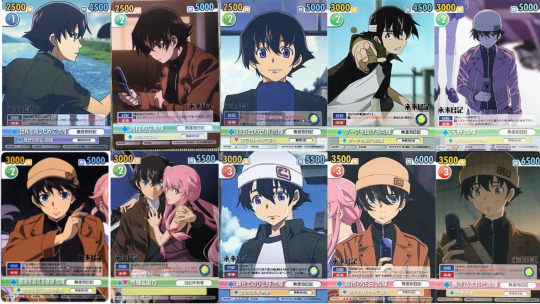

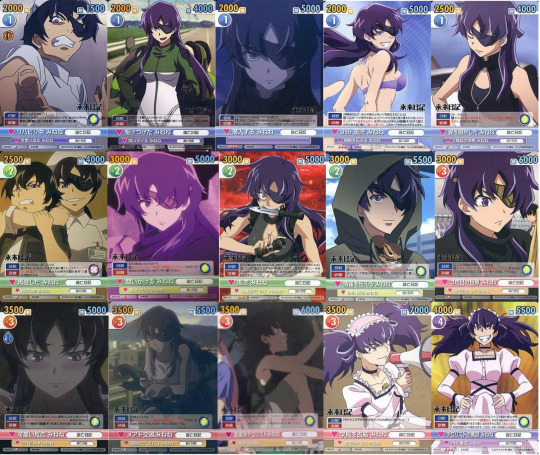

I also found images of the holographic and signed cards:

As well as the back of the cards, booster pack and trial deck packaging:

This means I'm missing... 81 cards.
*Sighs* I knew going into my research that I wouldn't be able to find every single one of them, but I'm still bummed that I'm missing over half. Anyway, I guess that this still serves as an overview for the VS Future Diary cards.
However, upon researching, I found this card that I thought was quite odd:
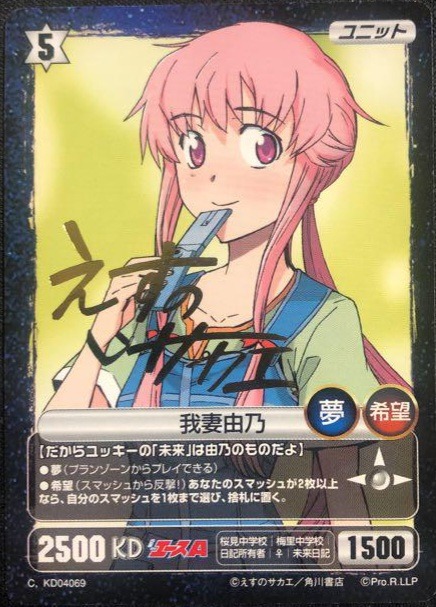
For instance, the frame of the card indicates that this is from a completely different line than VS, lacking all of the aforementioned details of its cards, not to mention that the artwork uses the style of the manga instead of the anime one (meaning this card is older than the VS ones). In other words, we got another card line in our hands, but the details of that one will be going up on a different post, since this one's already quite long. So till then, toodles.
#future diary#mirai nikki#anime#yandere#yuno gasai#the future diary#TCG#Victory Spark#Sparking Victory
17 notes
·
View notes
Photo




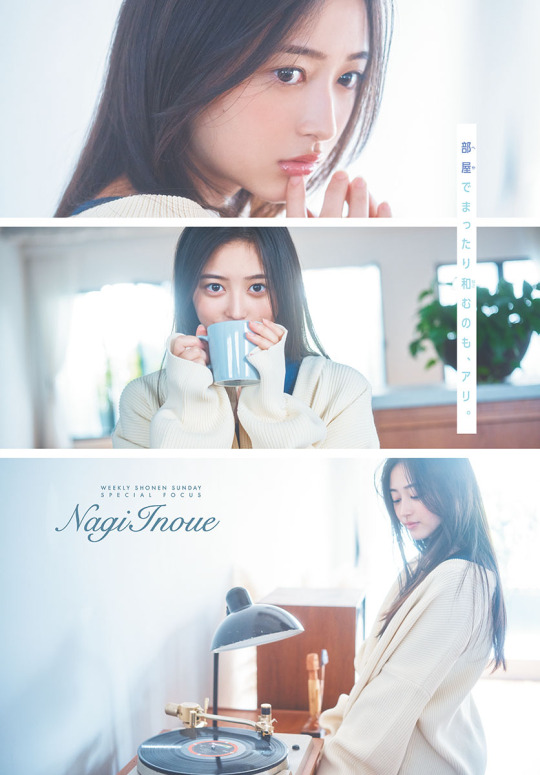


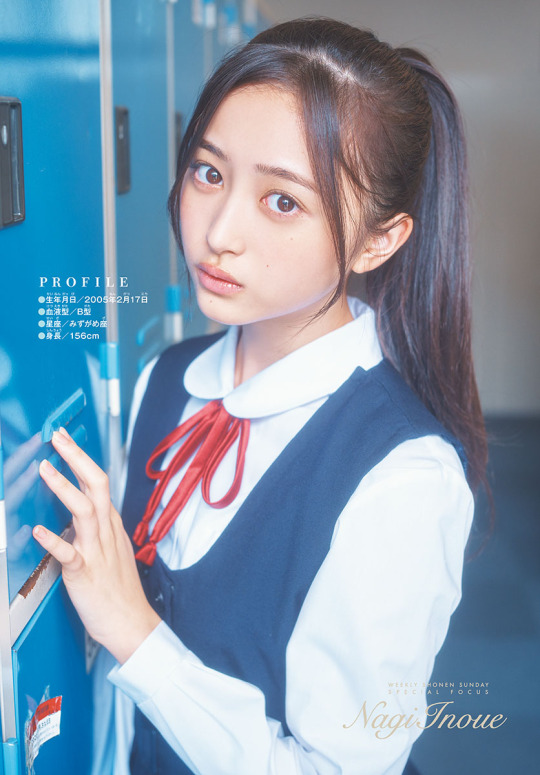

週刊少年サンデー No.22・23 2023年5/17号 (2023/4/26)
‘’5期生オーディション少年サンデー賞受賞!’’ 井上和 from 乃木坂46 5期生
42 notes
·
View notes
Video
youtube
“The Truth is Always One Piece of Treasure” ONE PIECE × Detective Conan Collab
Gosho Aoyama and Eiichiro Oda have a major thing in common: They both are the creators of popular currently running manga series with over 100 volumes. To commemorate this, the two authors will have a miraculous dialogue that spans magazines.
The first part of the dialogue will be released in the 34th issue of Weekly Shonen Jump released on July 25th. The second part will be released in the 35th issue of Weekly Shonen Sunday on July 27th.
In 2019, Aoyama was interviewed for a magazine where he expressed interest in talking with Oda, who he considered a comrade as both creators had series that are serialized weekly in magazines and broadcasted weekly on TV at the same time. Last year, in the 49th issue of Shonen Jump, Oda congratulated Aoyama on Detective Conan publishing its 100th volume, also calling him a “comrade in arms.”
#ONE PIECE#detective conan#dcmk#case closed#gosho aoyama#eiichiro oda#shonen jump#shonen sunday#weekly shonen jump#weekly shonen sunday#manga
52 notes
·
View notes
Text
"Ghost Sweeper Mikami: The Great Paradise Battle!!" magazine covers from the 'Weekly Shonen Sunday'.



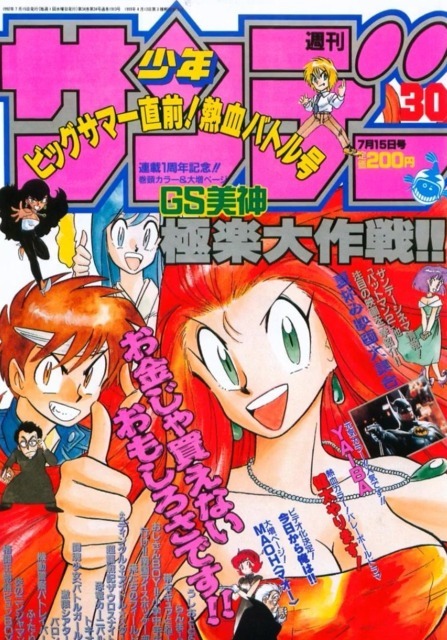

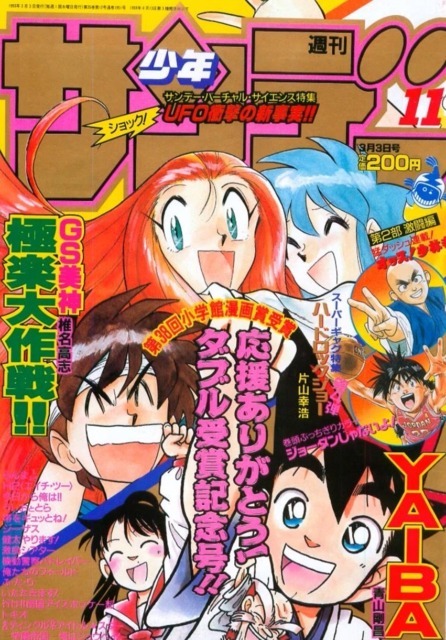

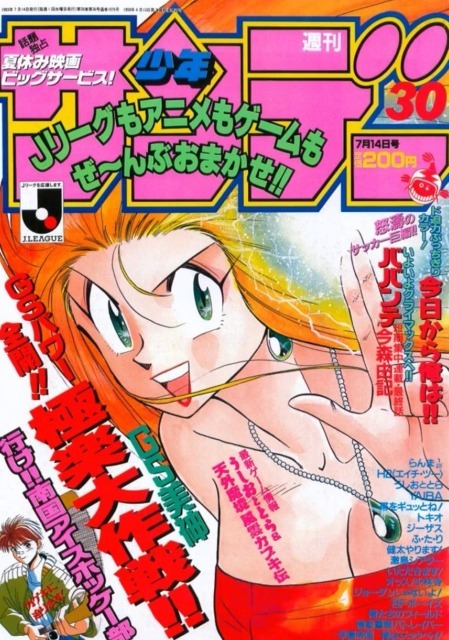



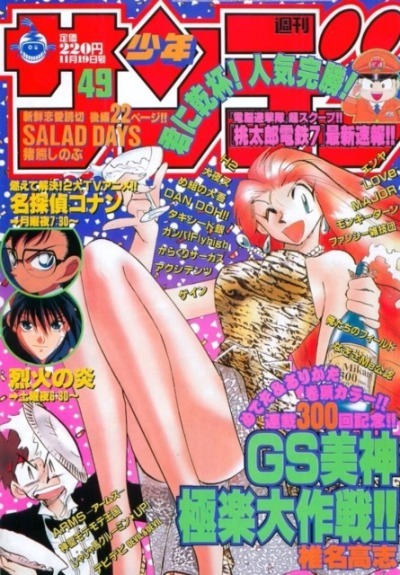


#surprise!! guess who hunted down all of these online??#since theres more content than usual regard this as a special post#i only picked the ones where gsm has the main (or atleast half) focus#or else we might have even more if we were counting brief cameos in other issues#and thats a chore#also yeah#for once i decided to use the full title since this post is a bit more special ;)#ghost sweeper mikami#gs mikami#reiko mikami#yokoshima tadao#okinu#kinu himuro#only tagging the main trio this time#official art#takashi shiina#dailyGS#weekly shonen sunday#manga#and since one if the volumes is shared..#yaiba#yaiba kurongane#sayaka mine#gosho aoyama#god i love them sm
9 notes
·
View notes
Text
Anime and Manga Log [5/28/23]
Over the years I’ve thought about doing a blog to post my thoughts about various manga and anime. Recently my good buddy @silvertsundere started a weekly AniManga post where he posts some short thoughts each week. I however, usually have a lot to say. It would take me forever to write up long discussions about every single chapter update I read each week. So I’ll be picking out a few titles to talk about each week. From Jump I will discuss my weekly top 3 and anything else I want to talk about.
Weekly Shonen Jump has been the core of my reading diet for nearly 15 years now. I have been following Shonen Jump since the mid-2000s when Viz was releasing the print magazine. Later around mid-2008 and into 2009 I got into Ohba and Obata’s Bakuman. This lead me to learning about the toc rankings and I started following the magazine religiously. I love the raw energy of a Shonen Jump series. Due to the competitive nature of its ranking system the series are always trying to improve themselves and catch the readers off guard. There’s nothing else quite like it. In comparison, Shonen Magazine series frequently have an emphasis on romance (and fan service) or its a sports manga. Shonen Sunday titles are usually very chill. They prefer to develop characters at a slow natural pace. Jump series always have something happening since losing readership could cost them a position in the magazine. I’ve been entertained by series of all genres short and long out of Jump. In fact it was talking about Nisekoi that made my Tumblr blog semi-famous in 2014-16. The creed of “Friendship! Effort! Victory!” will never fail you.
I’m currently reading everything from Weekly Shonen Jump, most Jump+ titles, and a few other series from other magazines. My Kodansha reads are paused at the moment because KManga is a bad app. The only Shonen Sunday series I am caught up with is Frieren (on hiatus). Eventually I’ll get caught up with a few others so I can follow Viz Media simuls. I generally only read official releases and prefer to keep scanlations to a minimum.
So without further ado, discussion for the series listed below are under the Keep Reading. I’m hoping to make this a weekly post going forward. There will be spoilers and opinions below. Be warned.
- Sakamoto Days Ch.120
- Blue Box Ch.102
- Cipher Academy Ch.25
- Naruto: Konoha Story Ch.15 [END]
- Pokemon Horizons Ep.8
- Soaring Sky! Precure Ep.17
Sakamoto Days 120:
Sakamoto Days is the mindless action series in the line-up right now. Its very much inspired by movies like John Wick. Lately we’ve been a backstory about Uzuki and Sakamoto’s relationship. The biggest selling point of the series is Suzuki’s endless creative imagination of cool set pieces. They never cease to amaze me with how the character interact with the location to defeat their opponent.
If I had to guess, the series is about halfway complete right now. Still a ways to go, but plotlines are starting to center around the baddie of the series. This week’s chapter finished the backstory with a fight between Sakamoto and Uzuki. Instead of the grand speculate we usually have, this fight was more grounded. No dialogue for half the chapter. Just a rapid exchange of blows. Leaving the backstory in Uzuki’s pov shows this how incident is still something he thinks about, and connects his character to Sakamoto.
I always look forward to reading this series. When is the anime going to be announced?
Blue Box 102:
The series just cleared its 2nd anniversary and its going as strong as ever. Blue Box is a slow burn romance following our main couple struggling in sports and love. Its a story filled with youth and presented with the thin loose line work of Kouji Miura. She always puts an emphasis on capturing a character’s expressions in the moment. It will frequently hold a reaction shot to show specific mannerisms.
Lately, the series has been gearing up for a long awaited confession between Taiki and Chinatsu. Its been a long time coming, though I am unsure if the series will actually do it. Rom-Coms aren’t known for changing the status quo in the middle of the series. This week’s chapter teases our main couple being much closer than they imagined in terms of proximity. They’re both unknowingly to the other in the same area. That’s lead Taiki on a fast sprint to catch up with Chinatsu.
Will they meet each other or just barely miss? Its hard to say. The scenery shot of the frozen lake in this week’s chapter was very pretty.
Cipher Academy 25:
The return of Nisioisin to Jump was near the top of my wish list, and I can confidently say he’s been delivering week after week. The story is about an academy of code solvers where literally every single thing is decided by your ability to decode a puzzle. It’s such a Nisioisin concept. Unfortunately it doesn’t seem to be catching on with readers. Cipher Academy has been ranking low in the toc rankings.
The recent chapters have been getting down to business with moving the plot to its ultimate goal of unearthing the big Crypto collection (yes you read right that, Nisio is writing about Crypto of all things) hidden deep within the academy. The leading Class Private of each class are going to participate in a tournament arc to determine the “Code Emperor”. Now admittedly for a manga about codes, they don’t matter that much in the grand scheme of the writing. The codes are always plot devices for the characters to interact around.
Nisio’s greatest strength of conveying character traits with eccentric dialogue is very much here, and with the added visual language of Iwasaki art. Together they compliment each other quite well. But anyhow, Nisio tournament arc sounds like its going to be exciting. Iroha is going to have to put his brain into overdrive to outwit his peers. Don’t get cancelled on me Cipher Academy!
Naruto: Konoha Story Ch.15 [END]
This finishes the pair of Naruto Light Novel manga adaptations that began last fall. Konoha Story was previously adapted into Boruto so I was already familiar with the story.
It followed Mirai learning to believe in herself more and discovering the legacy she’s been left. Throughout the story we had cameos from several old character each of whom imparted some wisdom into Mirai. Sadly, it falls into the trap of all post-Naruto. They rely on recycling old plotlines instead of pushing the canon forward. In this case because the story is about Mirai and since Asuma died to Hidan, from the Jishin cult, Mirai has to face someone from the cult in modern day. Luckily, Kishimoto left a good foundation with the team 10 dynamics for the story to work with.
At the very least Mirai’s character feel more natural in the world and something we were bound to see at some point. Overall, enjoyable and the manga was a nice way to experience the story again.
[Final Score: 6/10]
Pokemon Horizons Ep.8:
We’re two months into the new Pokemon anime and its finishing the prologue phase of the story. We’ve had intro arcs for both Riko and Roy. They each have an ancient artifact that’s sure to connect to a bigger plot. We know very little about the villain group right now. However, its still been great so far!
First, its refreshing to have a female protagonist for a change and have main characters who can have organic character development. I guess placing them both school better connects to the target audience and game characters. Poor Riko only got to spend 1 episode in school before getting swept up in the plot. I appreciate slower pace of long running anime.
Episode 8 focused on the streamer character Dot. She’s a shy in person, but puts on a high energy performance on the internet. Similar to the seiyuu’s counterpart in Bocchi. Exciting things are ahead as the gang is about to land in Paldea.
Soaring Sky! Precure Ep.17:
I started watching Precure weekly during the 15th anniversary series Hugtto, and here we are at the 20th series Soaring Sky. Precure series often have some of the most solid character writing among airing shows. Unlike 1 cour incomplete adaptations, Precure gets 4 whole cours to flesh out its characters.
Soaring Sky is a return to form with a focus on a central main duo and hand to hand combat. The cure designs are better made than usual for animation. That allows for most episodes to feature some nice movement or character acting when it matters most, as seen once again in this week’s episode.
Sora was tasked running a relay, and she wanted Mashiro to be the one passing the baton. It was a cute story that once again reinforces the friendship bond shared between our duo. Despite monster fight feeling tacked onto the scenario this week, it featured some slick movements. Next episode is the long awaited debut of Cure Butterfly. Ageha can finally start on Precure adventures as one of the squad.
Full read/watch list for the week:

5 notes
·
View notes
Text
Dynasty Warriors Inspired Game Idea (Manga's)
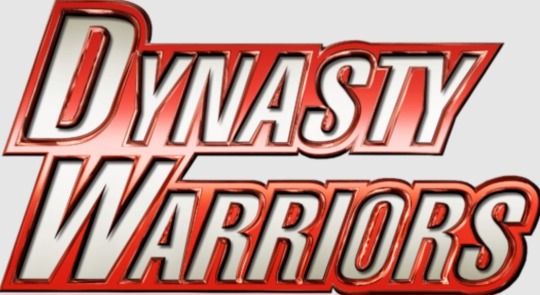




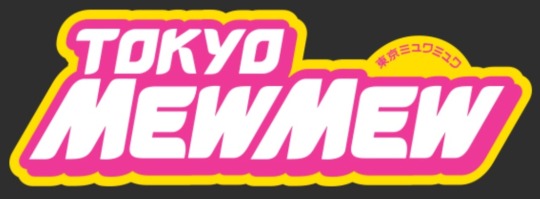




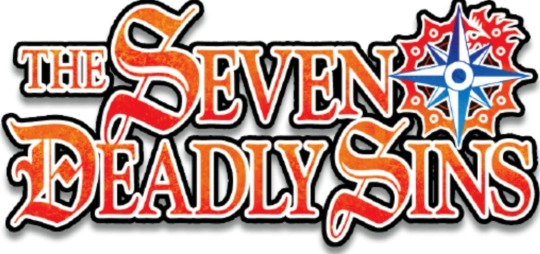
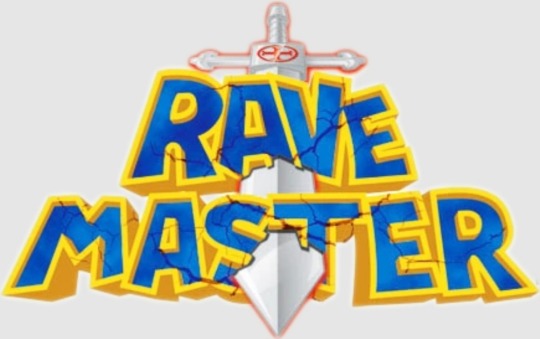
Here's an example of another Dynasty Warriors Inspired 'Crossover' Game, One Piece: Pirate Warriors 4;
youtube
#Dynasty Warriors#Naruto (Series)#My Hero Academia#Sailor Moon (Series)#Tokyo Mew Mew/Mew Mew Power#Soul Eater (Series)#Akame ga Kill!#InuYasha (Series)#Märchen Awakens Romance/MÄR#The Seven Deadly Sins (Manga)#Rave Master#Crossover#Question Poll
1 note
·
View note
Text
Weekly Shonen Jump Manga Round-Up(2023-03-26)

It’s the weekly manga review once again! I’m going to be talking about any thoughts I’ve had on manga that were released this sunday. The ones which I care about and have extensive thoughts on will get their own sections while the others will be packaged into one paragraph at the end. Click the ‘Keep reading’ to take a look!
Tokyo Demon Bride Story(Chapter 28)

Again, the impending feeling of cancellation looms over the series as the stakes are racheted through the roof with a once in several centuries evil threat rising and attacking our heroes while a wistful narration weaves through. I think until it ends, Tokyo Demon Bride Story will get its own paragraphs, as it's a useful vehicle to talk about how Shonen Jump cancels its stories. I understand it’s a business but it feels as if over the years, the editorial has gotten out of touch with the fact that it sometimes takes time to develop and find the core of the story, especially in a magazine like Shonen Jump. In the past, they let stories like Shaman King and Katekyo Hitman Reborn! meander for around 30 and 60 chapters respectively. Doing so not only allowed the story to develop it’s characters and dynamics but also establish a rhythm to normal life that felt absolutely earth shattering when it was disturbed. With how often I talk about Reborn! and Shaman King, I should really go back and talk about them. But to get back to the point, letting the story find it’s core paid off, as Shaman King utilized it’s easy going early chapters to find a balance between the zen and buddhist nature of it’s story and the need for shounen action, whereas Reborn! did the same with slice of life comedy and action. Tokyo Demon Bride Story has a strong core of slice of life moments that, if focused on, could lead to interesting story dynamics in the future, but it feels all a little too late to talk about. I personally think that the ideal balance of slice of life story and drama amongst shounen battle necessities was achieved in Lucifer and The Biscuit Hammer, as we found out about our characters lives while they waited for the next attack. Comparable stories also include Neon Genesis Evangelion and the Persona games. With the downtime between threats forcing the characters to commit to and live life to their fullest, we get a lot of beautiful moments. I hope future manga get a chance to flourish, Shonen Jump has to realize this isn’t a sustainable strategy.
Ginka and Gluna(Chapter 27)
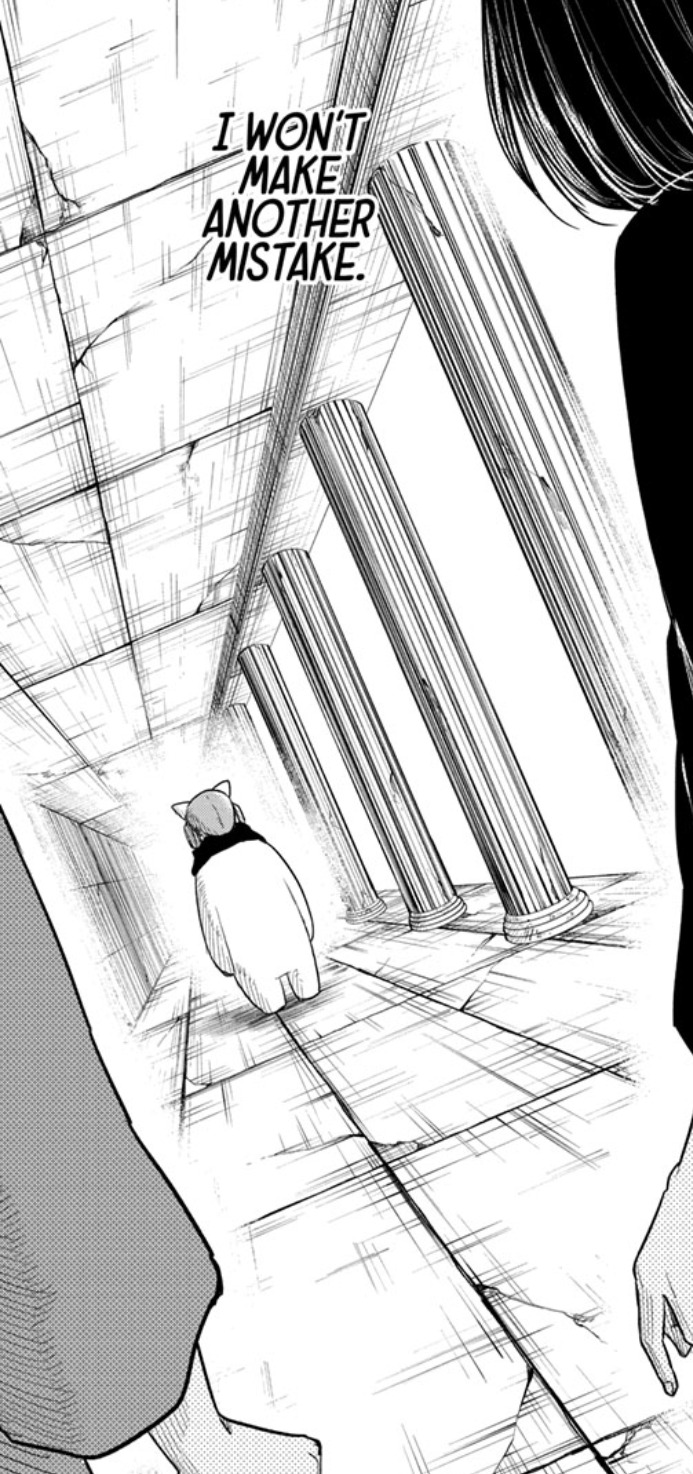
This manga definitely benefits from being binged, though this week's chapter packed a punch regardless. The story had been moving at a rather breakneck pace before this, but finally we slowed down, only to get hit with a gut punch. We miss out on a lot of memories in between, but we see Ginka’s tragic backstory, and see the mistakes he’s made as well as the mistakes he thinks he’s made. We also find out he has a deeper relationship with Magaraka than was previously assumed. Ginka’s always been aloof and I feel like it’s always been somewhat of a false front as there’s moments where he genuinely struggles. He’s supposed to be the Overpowered protagonist stereotypes like other contemporaries such as Saitama, Sakamoto and Mashle, but in truth he’s a lot more vulnerable. He’s looking for a way to restore his body and he’s not as strong as he once was. And even though his mantra when teaching Gluna was that there’s nothing a wizard can’t do, he doesn’t believe and it’s quite evident at times. So it’s even more devastating that, in a burst of confidence, he challenged a foe they couldn’t defeat and his pupil had to suffer the consequences. It explains the crushing negativity he’s experiencing and it’s totally warranted. I also love how this manga dips into absolute horror and despair quite often, as with the circumstances surrounding Ginka’s childhood and his sister. It’s a sign of confident storytelling that this manga can dip between Gluna’s optimism and wonder at the world and the absolute crushing reality of their circumstances. I really like how they’ve established Magaraka as the bad guy, he’s been sprinkled throughout and I could see him slinking away and building power like Ganndorf. We haven’t had much face time with him, but he’s already despicable in a really unique way that still makes you root for his defeat. Though I do want to see Gluna’s memories restored as I love the characters, but it might be more interesting to continue the journey without doing so.
Fabricant 100(Chapter 15)

I’ve been somewhat hesitant to label Fabricant 100 as ‘good’. There have been flashes of brilliance but I wasn’t sure if those were coincidences or not. But with this chapter a lot of these moments really come together to prove how intentional all of it was. With the second major and emotional story about the Fabricant’s we see a clear pattern develop. Underneath it’s disguise of a shounen series, Fabricant 100 seems to be concerned with questions of life and humanity and has set about examining them in quite profound ways. We have these beings who seem to feel no remorse but they understand all of the elements to it. So we have to ask the question ‘what separates understanding and feeling?’ and suddenly we’re thrown into a discussion on empathy. And these few moments after the Fabricant dies where we see them express what appears to be regret and sorrow, is that real? Is the manga saying death is what makes them human or is it that they never had the chance to grow and would’ve learned if given enough time? It’s somewhat of a cosmic horror that these powerful beings are compelled to act in such an unnatural way. We, as the readers, want so badly for them to be able to break these bonds but the manga sticks to its guns regarding those rules, rendering the atmosphere discordant and horrific in a hard to describe way. I could care less about the shounen elements but I am fully invested in its story now, and eager to see how Fabricant 100’s quest for answers about herself lead to further enlightenment. I love her character so I can only hope for some sort of emotional development.
Cipher Academy(Chapter 17)
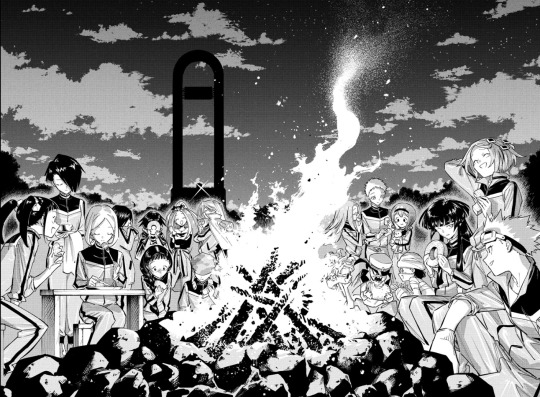
Each week, I look forward to Cipher Academy more and more. After the incredibly dense murder mystery game we get a little breathing room where we learn about our cast of characters. But before we talk about that, I just wanna gush about the art. I love the character designs in this manga so much and I absolutely adore the way Toshusai’s group always poses. It’s so ridiculous and endearing and while it’s taken a while for my perception of her as the villain to fade away, these things help to show how dorky she really is. One thing I am a little unclear on is the stakes of Cipher Academy. Obviously the decorum of this world is it’s own thing, with characters being exaggerated caricatures the norm, but is there an actual possibility of the students dying? The world of Cipher Academy takes an investment as even though it’s set in our world and references it quite heavily, a lot of the behaviors and modes of conduct betray more of an isekai plot setting. I haven’t had the pleasure of reading or watching the authors other work so I can’t say for sure if this is his style but I really like how unique it is. Okay, now let’s get back to this chapter. We see Iroha excited that he doesn’t have to solve ciphers but soon after see him not only begging for them but examining everything in the context of a puzzle. This place has done some major damage to my boy. We also see a lot more of his classmates acknowledging him and more of a sense of community develop, even before the bonding exercise. And it’s this exercise, which Yosaimura suggests, that catapults her to the frontrunner in the class private race. I don’t know how many of Iroha’s other classmate’s share his goal of peace but Yosaimura seems to be a kindred spirit. Here’s also where I acknowledge that I don’t see why Iroha needs to become the class private other than his desire to treat everything seriously or gather more allies. Yosaimura seems to like the perfect candidate for the private role as not only was she able to suggest an acceptable activity, showing clear understanding of the task and her peers, but she was also able to weave in her own desires and gain admiration from her peers as well. Alls that to say that I’m a fan. The dynamics established so far are really interesting as well. The main players right now are Iroha as our hero and Kogoe as the somewhat villain. Ensa is the first of what appears to be Iroha’s subordinates and Toshusai is his rival. It’s with Yosaimura’s introduction into the story that we see what Anon’s role is going to be. Where Toshusai is his rival, Yosaimura and Anon are much more capable than Iroha, representing a sort of paragon of good and evil respectively to strive towards. As we appreciate the warmness of camaraderie amongst our cast, Yosaimura drops the proverbial bomb, in which she reveals her goal was to show how people in war don’t get to enjoy what they just had, shedding so much light on her character all in one instant. She also is able to almost single handedly alter the mood of the entire class, once again painting her as the obvious choice. And that’s why I think that she won’t be able to win the nomination and if the stakes are really death then she might even die. But it does provide Iroha a good example to strive towards. At the end of the chapter we see Anon conspiring with Kogoe and we see them once again propped up as villains.
Witch Watch(Chapter 102)

We haven’t met another weirdo in such a long time that I just have to talk about this chapter. I love Fran so much already. A Frankenstein based shut in is such a good addition to the cast. Her method of rejecting people is also hilarious. And I don’t know about her, but Rui and Miharu’s exchange sounded suggestive the whole time through. At first I thought he was talking like that because he knew Fran was listening but it’s even funnier knowing it’s just the way he talks normally. It’s a 100% consistent with his trickster identity. I also love Fran’s character design so much, it was easy enough to tell that she was based off of Frankenstien but her seeking to make robots instead of flesh monsters is a nice change as it helps keep it PG. One thing that’s really neat about Witch Watch is that if characters are a part of a certain character’s world, they only interact with character’s outside of their social circles organically. It’s built up quite a living and breathing world through that.
Akane-Banashi(Chapter 55)

These two new characters that we’ve been introduced to, Tama and Kaichi, are really interesting. It seems like it’s a running trend with the great character introductions this week. I wasn’t sure what I found interesting about them until I realized that a point was made about their newness to the scene. These two characters create an interesting dynamic because they seem to be the first few characters that Akane doesn’t need to learn things from but are still her peers. And besides the dynamic, they’re interesting characters in and of themselves. Kaichi devoting himself to Rakugo later in life and his wistful way of talking coupled with the sly info drop of him being a salesman paints an interesting character to pair with his expository older brother type personality. Tama is definitely the more interesting characters as he lacks confidence but is still somehow able to hold his own enough to apprentice under who seems to be as formidable as Ikken. The exposition this round also helps to prop up Akane as the prodigy she is, and gives her some much earned credit. And one last thing I want to mention, I love Akane's signature look, as shown in the panel above, of having her arm before her in a sort of defensive stance. It calls back to Bruce Lee thumbing his nose before a fight while also being a distinctive character pose. It shows her defensive nature but also that she's ready to attack at any moment.
Undead Unluck(Chapter 152)

I love this chapter so much. Using Billy’s initial trait of untrustworthiness and not having faith in others to turn around and have his power become acknowledging and trusting others is such a beautiful way to tell his story through technical plot elements that I can’t get over it. And not only does this manga pull that off magnificently, it also weaves it through his backstory while justifying his viewpoint before having Fuuko shatter that viewpoint. It’s hard to be eloquent and in depth about something as intelligently and empathetically done as this. The story has immense love for it’s character’s and treats them with respect. And once again, having Billy’s power represent his change from wanting to shoulder all the burdens himself to trusting others in such a way is genius. Also the fact that Fuuk achieved such a feat, changing a man’s entire worldview in one moment in such a believable way is such a testament to the writing as well as Fuuko as a character. She’s grown so much since we first saw her and I love how the above displayed page shows off her intensity and empathy.
The Ichinose Family's Deadly Sins(Chapter 18)

And so the other shoe drops. While everyone else has tried to go on living after the accident, the past 17 chapters have been inside Tsubasa’s head as he dreams during his coma of four years. We watch as his mom mourns her son and feels guilty about the dreams she’s been having. She goes to the roof to probably kill herself only to find Tsubasa’s dad there as well, about to jump off. The chapter ends as they both come to the conclusion that they’re having the same dream. Taizan5 finally hits us with the sobering reality in this chapter and it’s absolutely tragic. But through whatever dream magic this is happening, they’ve been given a literal second chance. I’m curious to know if Tsubasa’s other family member’s survived. This development in the story tee's up for one last permanent change. Though it won’t change the past, this revelation is the Ichinose Family’s one last chance to make it right. It’s honestly a brilliant way to portray the themes of growth and change. This manga did it’s best to put forth the message that it’s never too late to change the way you live going forward, but doing it through the plot device of repeating time loops felt off and kind of hollow. But now, with the reveal that everything is permanent? It presents the perfect opportunity to fully cement those themes.
THE LEFTOVERS
Today’s release date also coincided with another release of Naruto: Sasuke’s Story-The Uchiha and the Heavenly Stardust(Chapter 8.2) where Sasuke continues his battle against the dinosaurs alongside his pet raptor. Yup, Sasuke has a pet raptor in this. There’s a reason why I don’t talk about this much. It was nice to see a side character that had been teased to have deeper motivations finally take the limelight with Meico finally solidifying her desire to beat Roboco in this week's chapter of Me & Roboco(Chapter 130). Ichigoki’s Under Control!!(Chapter 16) also seems to be in its final arc as they’re setting about to restore Misao to her normal height. Going on a Dragon Ball style hunt, they end up in a heavily stereotyped American prison and help to reform it. I don’t know if it was funny but it was definitely interesting… Tragedy strikes in Jiangshi X(Chapter 10) as our main character’s father gets stabbed while trying to help him escape. I’d always wondered about the colour in the titles but now it pays off with red blood on the last page. It was a well emphasized and earned moment. We get to see the new additions to the cast in an adorable chapter of Mission: Yozakura Family(Chapter 171). For the first time in a while, I didn’t have many complaints, this was quite a fun chapter. I really like the character’s the kids and it’s fun seeing Taiyo and Mustumi as parents. Mashle: Magic and Muscles(Chapter 149) once again uses Mash’s superhuman strength as it’s one and only punchline as he strikes a deal to come back to life. The art’s good though. This week’s chapter of The Elusive Samurai(Chapter 103) begins in a bizarrely dreamlike sequence before hurtling back towards battle again. In Blue Box(Chapter 94) we get a bittersweet story that contrasts Hina And Taiki with Natsu and Yumeko. It’s nice to see Yumeko develop and I find her to be a really engaging character but it’s always a rough chapter when Hina’s sadness is brought to the forefront. Here’s hoping for some happiness in her future, the manga needs to stop doing her dirty. In Sakamoto Days(Chapter 112) we get some insight on Sakamoto’s choice to have a family. We also get a rare look under Sakomoto’s stoicism through the sweet moment he has with Konomi. We get a little development for Mina and also learn about how we got to the current circumstances of the battle in My Hero Academia(Chapter 383). In Black Clover(Chapter 355) we get the start of the battle.
#weekly shonen jump#manga discussion#manga recap#manga#tokyo demon bride story#ginka and gluna#ginka & glüna#cipher academy#witch watch#undead unluck#the ichinose family's deadly sins#akane banashi#spoilers#fabricant 100#blue box
3 notes
·
View notes